Accounting Financial Analysis Report for Caffyns plc
VerifiedAdded on 2023/06/13
|33
|8388
|156
AI Summary
This report provides a detailed analysis of Caffyns plc, a motor vehicle retailer company in England. The report includes a strategic and operating analysis, accounting quality analysis, and financial analysis. The financial analysis includes trend analysis, ratio analysis, and investor analysis. The report concludes with a recommendation and conclusion for potential investors.
Contribute Materials
Your contribution can guide someone’s learning journey. Share your
documents today.

Running Head: Accounting financial analysis report
1
1
Secure Best Marks with AI Grader
Need help grading? Try our AI Grader for instant feedback on your assignments.
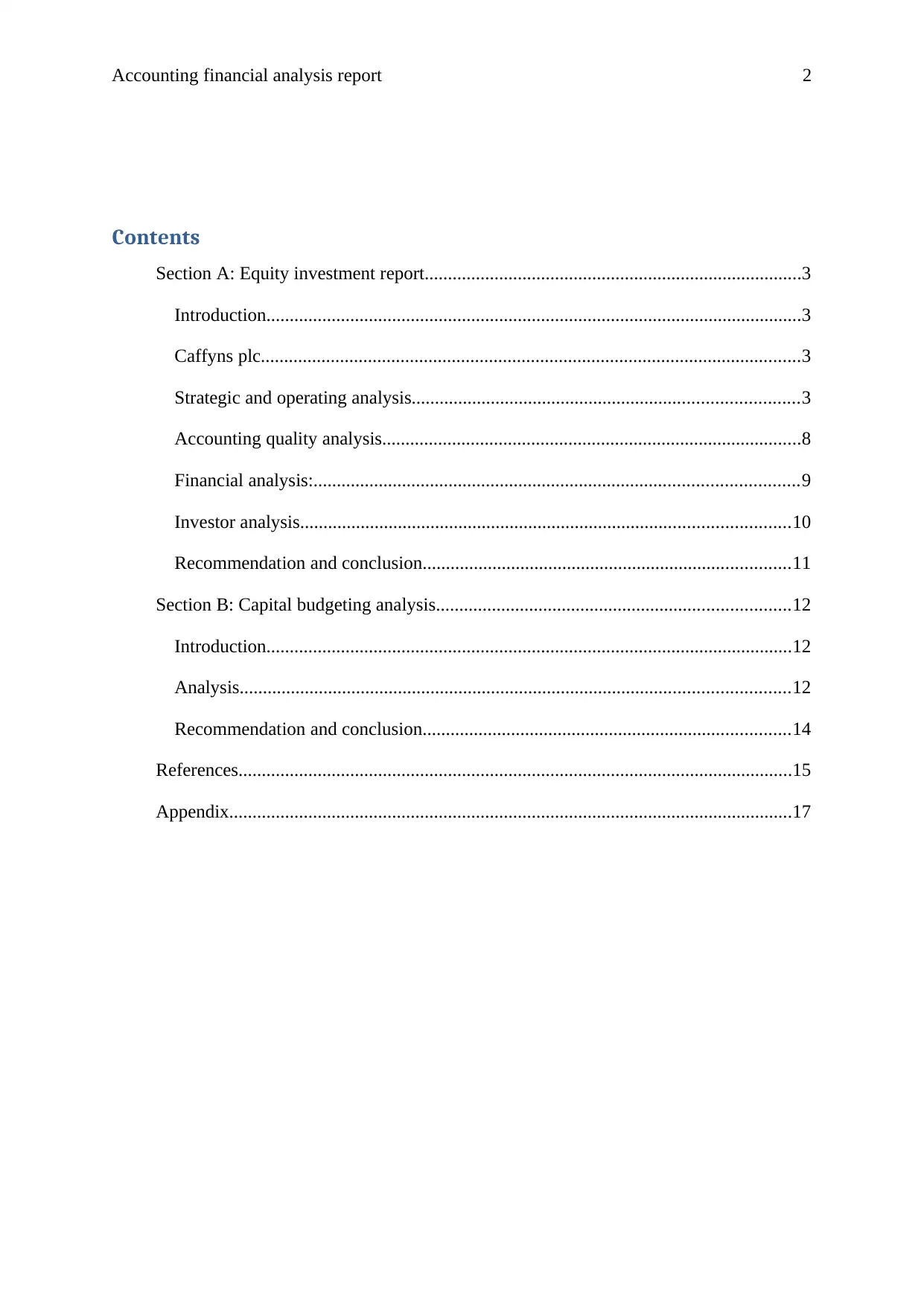
Accounting financial analysis report 2
Contents
Section A: Equity investment report.................................................................................3
Introduction...................................................................................................................3
Caffyns plc....................................................................................................................3
Strategic and operating analysis...................................................................................3
Accounting quality analysis..........................................................................................8
Financial analysis:........................................................................................................9
Investor analysis.........................................................................................................10
Recommendation and conclusion...............................................................................11
Section B: Capital budgeting analysis............................................................................12
Introduction.................................................................................................................12
Analysis......................................................................................................................12
Recommendation and conclusion...............................................................................14
References.......................................................................................................................15
Appendix.........................................................................................................................17
Contents
Section A: Equity investment report.................................................................................3
Introduction...................................................................................................................3
Caffyns plc....................................................................................................................3
Strategic and operating analysis...................................................................................3
Accounting quality analysis..........................................................................................8
Financial analysis:........................................................................................................9
Investor analysis.........................................................................................................10
Recommendation and conclusion...............................................................................11
Section B: Capital budgeting analysis............................................................................12
Introduction.................................................................................................................12
Analysis......................................................................................................................12
Recommendation and conclusion...............................................................................14
References.......................................................................................................................15
Appendix.........................................................................................................................17
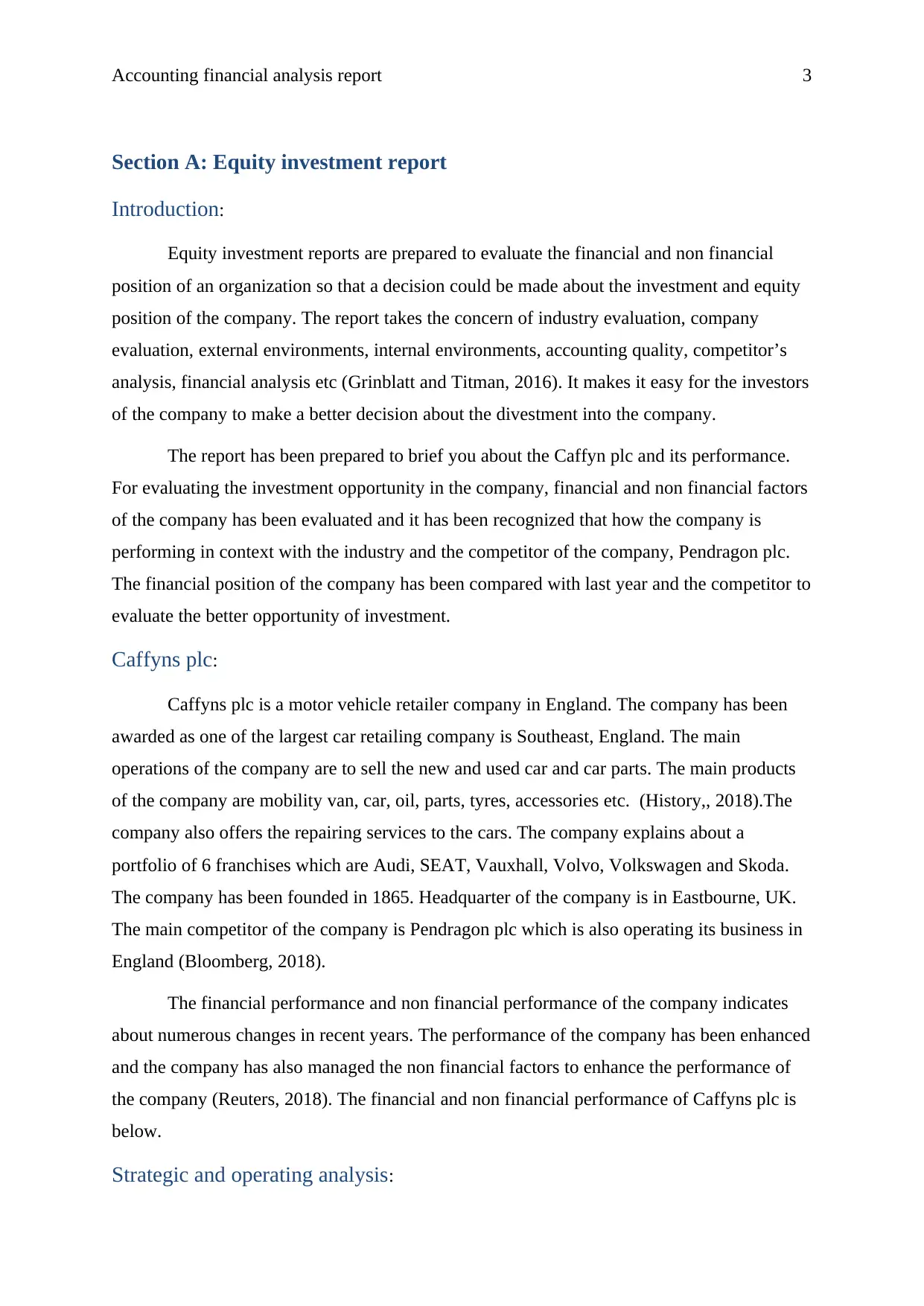
Accounting financial analysis report 3
Section A: Equity investment report
Introduction:
Equity investment reports are prepared to evaluate the financial and non financial
position of an organization so that a decision could be made about the investment and equity
position of the company. The report takes the concern of industry evaluation, company
evaluation, external environments, internal environments, accounting quality, competitor’s
analysis, financial analysis etc (Grinblatt and Titman, 2016). It makes it easy for the investors
of the company to make a better decision about the divestment into the company.
The report has been prepared to brief you about the Caffyn plc and its performance.
For evaluating the investment opportunity in the company, financial and non financial factors
of the company has been evaluated and it has been recognized that how the company is
performing in context with the industry and the competitor of the company, Pendragon plc.
The financial position of the company has been compared with last year and the competitor to
evaluate the better opportunity of investment.
Caffyns plc:
Caffyns plc is a motor vehicle retailer company in England. The company has been
awarded as one of the largest car retailing company is Southeast, England. The main
operations of the company are to sell the new and used car and car parts. The main products
of the company are mobility van, car, oil, parts, tyres, accessories etc. (History,, 2018).The
company also offers the repairing services to the cars. The company explains about a
portfolio of 6 franchises which are Audi, SEAT, Vauxhall, Volvo, Volkswagen and Skoda.
The company has been founded in 1865. Headquarter of the company is in Eastbourne, UK.
The main competitor of the company is Pendragon plc which is also operating its business in
England (Bloomberg, 2018).
The financial performance and non financial performance of the company indicates
about numerous changes in recent years. The performance of the company has been enhanced
and the company has also managed the non financial factors to enhance the performance of
the company (Reuters, 2018). The financial and non financial performance of Caffyns plc is
below.
Strategic and operating analysis:
Section A: Equity investment report
Introduction:
Equity investment reports are prepared to evaluate the financial and non financial
position of an organization so that a decision could be made about the investment and equity
position of the company. The report takes the concern of industry evaluation, company
evaluation, external environments, internal environments, accounting quality, competitor’s
analysis, financial analysis etc (Grinblatt and Titman, 2016). It makes it easy for the investors
of the company to make a better decision about the divestment into the company.
The report has been prepared to brief you about the Caffyn plc and its performance.
For evaluating the investment opportunity in the company, financial and non financial factors
of the company has been evaluated and it has been recognized that how the company is
performing in context with the industry and the competitor of the company, Pendragon plc.
The financial position of the company has been compared with last year and the competitor to
evaluate the better opportunity of investment.
Caffyns plc:
Caffyns plc is a motor vehicle retailer company in England. The company has been
awarded as one of the largest car retailing company is Southeast, England. The main
operations of the company are to sell the new and used car and car parts. The main products
of the company are mobility van, car, oil, parts, tyres, accessories etc. (History,, 2018).The
company also offers the repairing services to the cars. The company explains about a
portfolio of 6 franchises which are Audi, SEAT, Vauxhall, Volvo, Volkswagen and Skoda.
The company has been founded in 1865. Headquarter of the company is in Eastbourne, UK.
The main competitor of the company is Pendragon plc which is also operating its business in
England (Bloomberg, 2018).
The financial performance and non financial performance of the company indicates
about numerous changes in recent years. The performance of the company has been enhanced
and the company has also managed the non financial factors to enhance the performance of
the company (Reuters, 2018). The financial and non financial performance of Caffyns plc is
below.
Strategic and operating analysis:
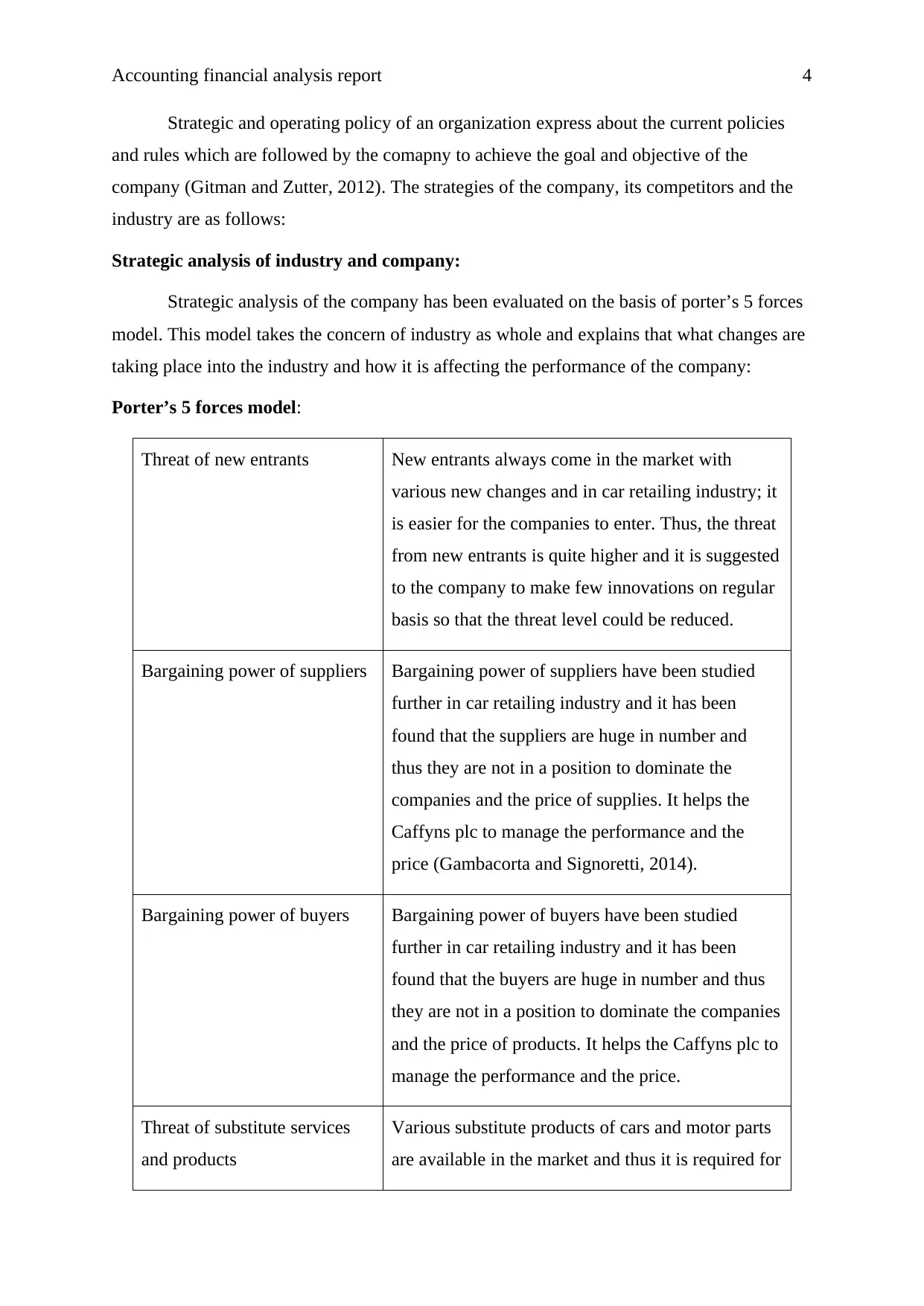
Accounting financial analysis report 4
Strategic and operating policy of an organization express about the current policies
and rules which are followed by the comapny to achieve the goal and objective of the
company (Gitman and Zutter, 2012). The strategies of the company, its competitors and the
industry are as follows:
Strategic analysis of industry and company:
Strategic analysis of the company has been evaluated on the basis of porter’s 5 forces
model. This model takes the concern of industry as whole and explains that what changes are
taking place into the industry and how it is affecting the performance of the company:
Porter’s 5 forces model:
Threat of new entrants New entrants always come in the market with
various new changes and in car retailing industry; it
is easier for the companies to enter. Thus, the threat
from new entrants is quite higher and it is suggested
to the company to make few innovations on regular
basis so that the threat level could be reduced.
Bargaining power of suppliers Bargaining power of suppliers have been studied
further in car retailing industry and it has been
found that the suppliers are huge in number and
thus they are not in a position to dominate the
companies and the price of supplies. It helps the
Caffyns plc to manage the performance and the
price (Gambacorta and Signoretti, 2014).
Bargaining power of buyers Bargaining power of buyers have been studied
further in car retailing industry and it has been
found that the buyers are huge in number and thus
they are not in a position to dominate the companies
and the price of products. It helps the Caffyns plc to
manage the performance and the price.
Threat of substitute services
and products
Various substitute products of cars and motor parts
are available in the market and thus it is required for
Strategic and operating policy of an organization express about the current policies
and rules which are followed by the comapny to achieve the goal and objective of the
company (Gitman and Zutter, 2012). The strategies of the company, its competitors and the
industry are as follows:
Strategic analysis of industry and company:
Strategic analysis of the company has been evaluated on the basis of porter’s 5 forces
model. This model takes the concern of industry as whole and explains that what changes are
taking place into the industry and how it is affecting the performance of the company:
Porter’s 5 forces model:
Threat of new entrants New entrants always come in the market with
various new changes and in car retailing industry; it
is easier for the companies to enter. Thus, the threat
from new entrants is quite higher and it is suggested
to the company to make few innovations on regular
basis so that the threat level could be reduced.
Bargaining power of suppliers Bargaining power of suppliers have been studied
further in car retailing industry and it has been
found that the suppliers are huge in number and
thus they are not in a position to dominate the
companies and the price of supplies. It helps the
Caffyns plc to manage the performance and the
price (Gambacorta and Signoretti, 2014).
Bargaining power of buyers Bargaining power of buyers have been studied
further in car retailing industry and it has been
found that the buyers are huge in number and thus
they are not in a position to dominate the companies
and the price of products. It helps the Caffyns plc to
manage the performance and the price.
Threat of substitute services
and products
Various substitute products of cars and motor parts
are available in the market and thus it is required for
Secure Best Marks with AI Grader
Need help grading? Try our AI Grader for instant feedback on your assignments.
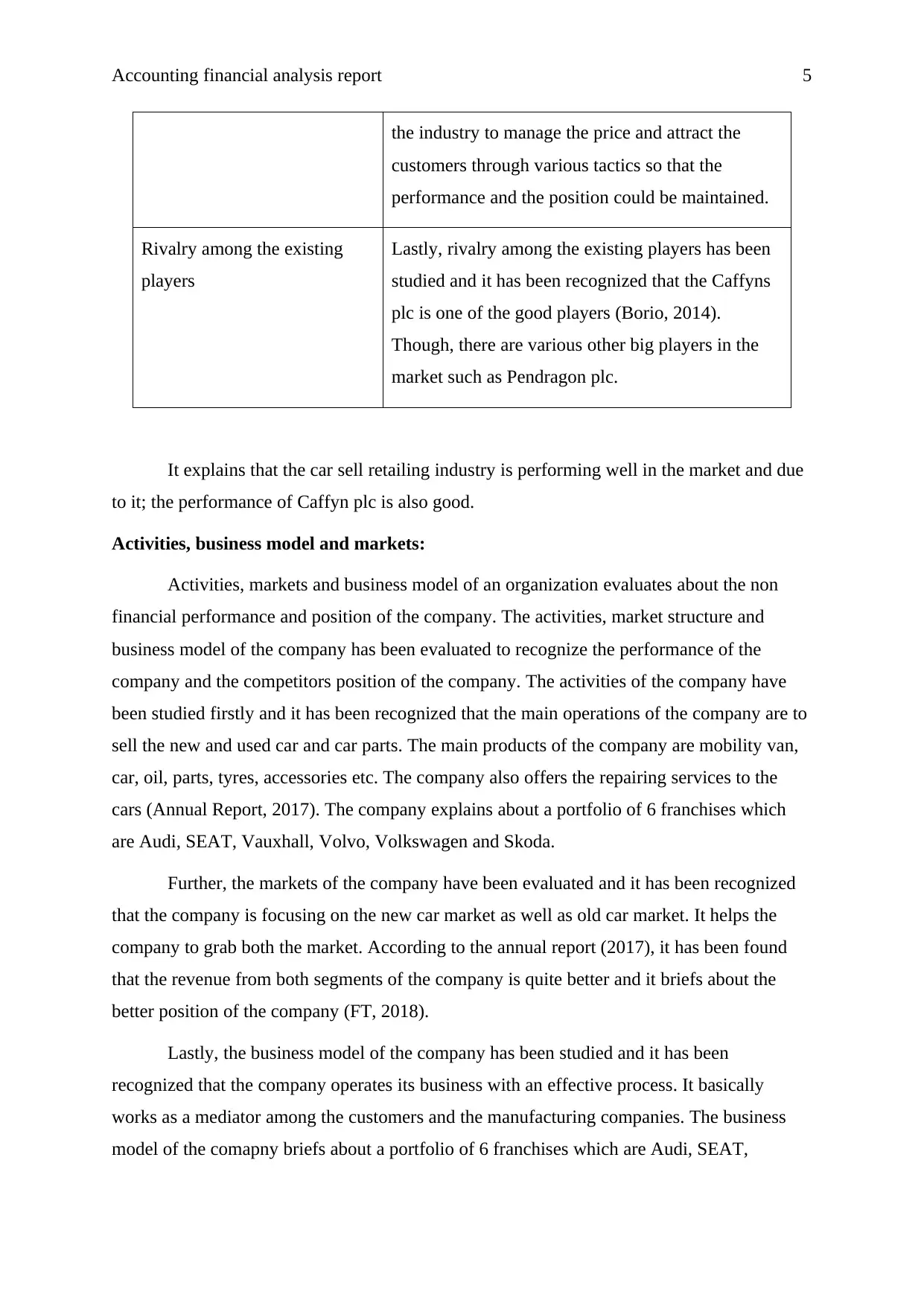
Accounting financial analysis report 5
the industry to manage the price and attract the
customers through various tactics so that the
performance and the position could be maintained.
Rivalry among the existing
players
Lastly, rivalry among the existing players has been
studied and it has been recognized that the Caffyns
plc is one of the good players (Borio, 2014).
Though, there are various other big players in the
market such as Pendragon plc.
It explains that the car sell retailing industry is performing well in the market and due
to it; the performance of Caffyn plc is also good.
Activities, business model and markets:
Activities, markets and business model of an organization evaluates about the non
financial performance and position of the company. The activities, market structure and
business model of the company has been evaluated to recognize the performance of the
company and the competitors position of the company. The activities of the company have
been studied firstly and it has been recognized that the main operations of the company are to
sell the new and used car and car parts. The main products of the company are mobility van,
car, oil, parts, tyres, accessories etc. The company also offers the repairing services to the
cars (Annual Report, 2017). The company explains about a portfolio of 6 franchises which
are Audi, SEAT, Vauxhall, Volvo, Volkswagen and Skoda.
Further, the markets of the company have been evaluated and it has been recognized
that the company is focusing on the new car market as well as old car market. It helps the
company to grab both the market. According to the annual report (2017), it has been found
that the revenue from both segments of the company is quite better and it briefs about the
better position of the company (FT, 2018).
Lastly, the business model of the company has been studied and it has been
recognized that the company operates its business with an effective process. It basically
works as a mediator among the customers and the manufacturing companies. The business
model of the comapny briefs about a portfolio of 6 franchises which are Audi, SEAT,
the industry to manage the price and attract the
customers through various tactics so that the
performance and the position could be maintained.
Rivalry among the existing
players
Lastly, rivalry among the existing players has been
studied and it has been recognized that the Caffyns
plc is one of the good players (Borio, 2014).
Though, there are various other big players in the
market such as Pendragon plc.
It explains that the car sell retailing industry is performing well in the market and due
to it; the performance of Caffyn plc is also good.
Activities, business model and markets:
Activities, markets and business model of an organization evaluates about the non
financial performance and position of the company. The activities, market structure and
business model of the company has been evaluated to recognize the performance of the
company and the competitors position of the company. The activities of the company have
been studied firstly and it has been recognized that the main operations of the company are to
sell the new and used car and car parts. The main products of the company are mobility van,
car, oil, parts, tyres, accessories etc. The company also offers the repairing services to the
cars (Annual Report, 2017). The company explains about a portfolio of 6 franchises which
are Audi, SEAT, Vauxhall, Volvo, Volkswagen and Skoda.
Further, the markets of the company have been evaluated and it has been recognized
that the company is focusing on the new car market as well as old car market. It helps the
company to grab both the market. According to the annual report (2017), it has been found
that the revenue from both segments of the company is quite better and it briefs about the
better position of the company (FT, 2018).
Lastly, the business model of the company has been studied and it has been
recognized that the company operates its business with an effective process. It basically
works as a mediator among the customers and the manufacturing companies. The business
model of the comapny briefs about a portfolio of 6 franchises which are Audi, SEAT,

Accounting financial analysis report 6
Vauxhall, Volvo, Volkswagen and Skoda. Caffyns plc sells the cars of these brands to the
customers of UK (Galí, 2015).
Objectives and policies:
Objectives and policies of an organization brief about the man target which has been
set by the management of the company and the entire organizations works as a team to reach
and meet the target. The main objectives of Caffyns plc are to analyze the new market for the
company and grab that market. Currently, the company is focusing on diversifying so that the
new market could be grabbed and the turnover of the company could be enhanced. The
company has prepared various new policies of human resources and financial management to
meet the objectives (annual report, 2017).
The objectives of the company have been prepared in such a manner that society
could not be harmed as well as the position and the performance of the company is enhanced.
The company wants to be leader in the market but various competitors are available in the
market to defeat the company (Simply Wall, 2018).
KPIs:
Key performance indicators of the company have been studied further to recognize the
changes into the performance of the company in context with the last year and the competitor
of the company. The key performance indicators of the company such as net profit, Earnings
per share, gearing ratio of the company etc explains that the performance of the company has
been better from the last year (Annaul Report, 2017). On the other hand, the Pendragon plc’s
key performance indicators explains that the performance of the company has been lowered
in financial year 2017 in context with the financial year 2016. It explains that the Caffyns plc
is a good option for the purpose of investment.
SWOT analysis:
SWOT analysis of the company has been done in addition to recognize the internal
strength and weakness of the company as well as the external opportunities and threats of the
company. The SWOT analysis study of the comapny is as follows:
Strength:
1. High growth rate
2. Better key performance indicators
Weakness:
1. Less market share
2. Competition
Vauxhall, Volvo, Volkswagen and Skoda. Caffyns plc sells the cars of these brands to the
customers of UK (Galí, 2015).
Objectives and policies:
Objectives and policies of an organization brief about the man target which has been
set by the management of the company and the entire organizations works as a team to reach
and meet the target. The main objectives of Caffyns plc are to analyze the new market for the
company and grab that market. Currently, the company is focusing on diversifying so that the
new market could be grabbed and the turnover of the company could be enhanced. The
company has prepared various new policies of human resources and financial management to
meet the objectives (annual report, 2017).
The objectives of the company have been prepared in such a manner that society
could not be harmed as well as the position and the performance of the company is enhanced.
The company wants to be leader in the market but various competitors are available in the
market to defeat the company (Simply Wall, 2018).
KPIs:
Key performance indicators of the company have been studied further to recognize the
changes into the performance of the company in context with the last year and the competitor
of the company. The key performance indicators of the company such as net profit, Earnings
per share, gearing ratio of the company etc explains that the performance of the company has
been better from the last year (Annaul Report, 2017). On the other hand, the Pendragon plc’s
key performance indicators explains that the performance of the company has been lowered
in financial year 2017 in context with the financial year 2016. It explains that the Caffyns plc
is a good option for the purpose of investment.
SWOT analysis:
SWOT analysis of the company has been done in addition to recognize the internal
strength and weakness of the company as well as the external opportunities and threats of the
company. The SWOT analysis study of the comapny is as follows:
Strength:
1. High growth rate
2. Better key performance indicators
Weakness:
1. Less market share
2. Competition
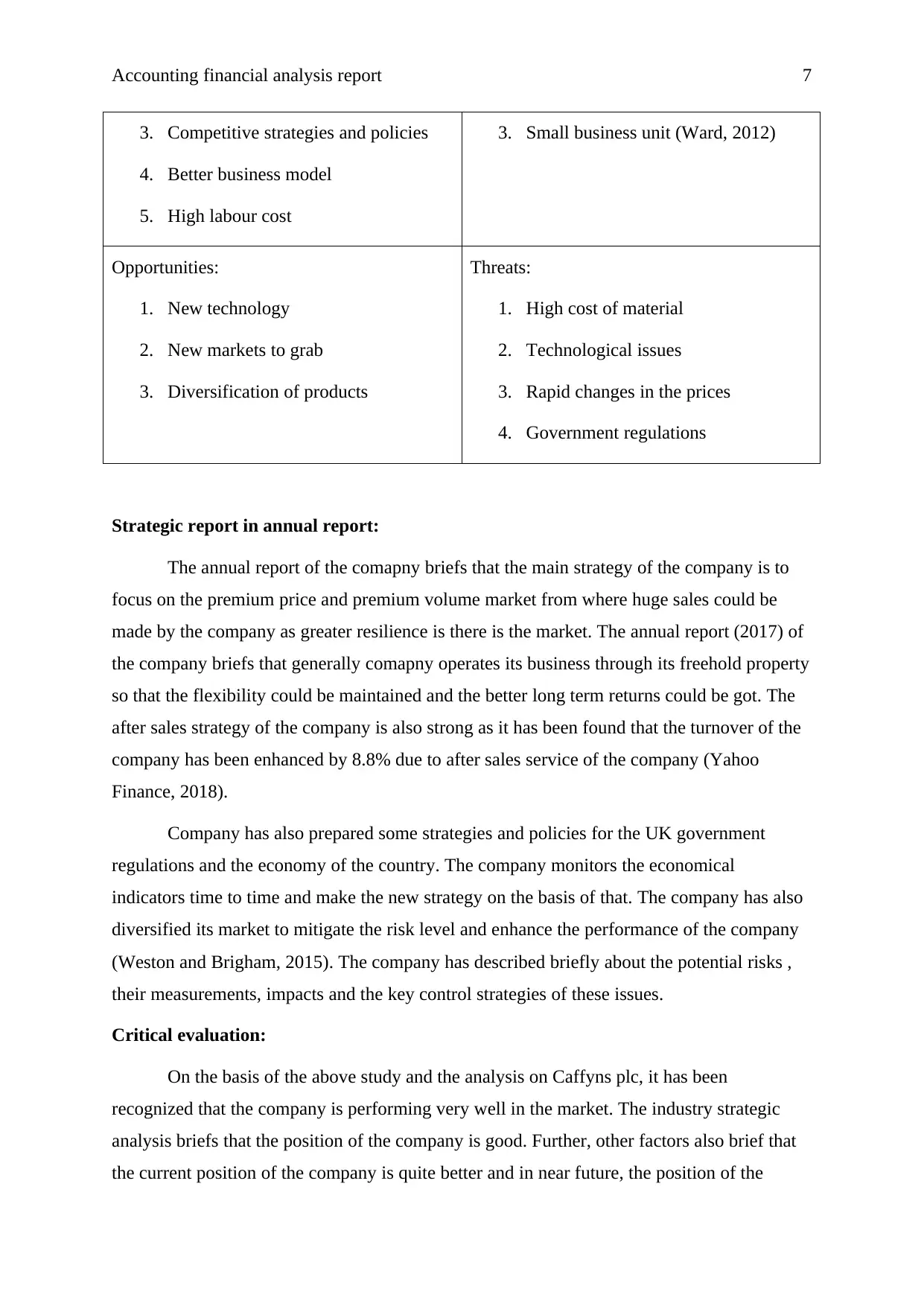
Accounting financial analysis report 7
3. Competitive strategies and policies
4. Better business model
5. High labour cost
3. Small business unit (Ward, 2012)
Opportunities:
1. New technology
2. New markets to grab
3. Diversification of products
Threats:
1. High cost of material
2. Technological issues
3. Rapid changes in the prices
4. Government regulations
Strategic report in annual report:
The annual report of the comapny briefs that the main strategy of the company is to
focus on the premium price and premium volume market from where huge sales could be
made by the company as greater resilience is there is the market. The annual report (2017) of
the company briefs that generally comapny operates its business through its freehold property
so that the flexibility could be maintained and the better long term returns could be got. The
after sales strategy of the company is also strong as it has been found that the turnover of the
company has been enhanced by 8.8% due to after sales service of the company (Yahoo
Finance, 2018).
Company has also prepared some strategies and policies for the UK government
regulations and the economy of the country. The company monitors the economical
indicators time to time and make the new strategy on the basis of that. The company has also
diversified its market to mitigate the risk level and enhance the performance of the company
(Weston and Brigham, 2015). The company has described briefly about the potential risks ,
their measurements, impacts and the key control strategies of these issues.
Critical evaluation:
On the basis of the above study and the analysis on Caffyns plc, it has been
recognized that the company is performing very well in the market. The industry strategic
analysis briefs that the position of the company is good. Further, other factors also brief that
the current position of the company is quite better and in near future, the position of the
3. Competitive strategies and policies
4. Better business model
5. High labour cost
3. Small business unit (Ward, 2012)
Opportunities:
1. New technology
2. New markets to grab
3. Diversification of products
Threats:
1. High cost of material
2. Technological issues
3. Rapid changes in the prices
4. Government regulations
Strategic report in annual report:
The annual report of the comapny briefs that the main strategy of the company is to
focus on the premium price and premium volume market from where huge sales could be
made by the company as greater resilience is there is the market. The annual report (2017) of
the company briefs that generally comapny operates its business through its freehold property
so that the flexibility could be maintained and the better long term returns could be got. The
after sales strategy of the company is also strong as it has been found that the turnover of the
company has been enhanced by 8.8% due to after sales service of the company (Yahoo
Finance, 2018).
Company has also prepared some strategies and policies for the UK government
regulations and the economy of the country. The company monitors the economical
indicators time to time and make the new strategy on the basis of that. The company has also
diversified its market to mitigate the risk level and enhance the performance of the company
(Weston and Brigham, 2015). The company has described briefly about the potential risks ,
their measurements, impacts and the key control strategies of these issues.
Critical evaluation:
On the basis of the above study and the analysis on Caffyns plc, it has been
recognized that the company is performing very well in the market. The industry strategic
analysis briefs that the position of the company is good. Further, other factors also brief that
the current position of the company is quite better and in near future, the position of the
Paraphrase This Document
Need a fresh take? Get an instant paraphrase of this document with our AI Paraphraser
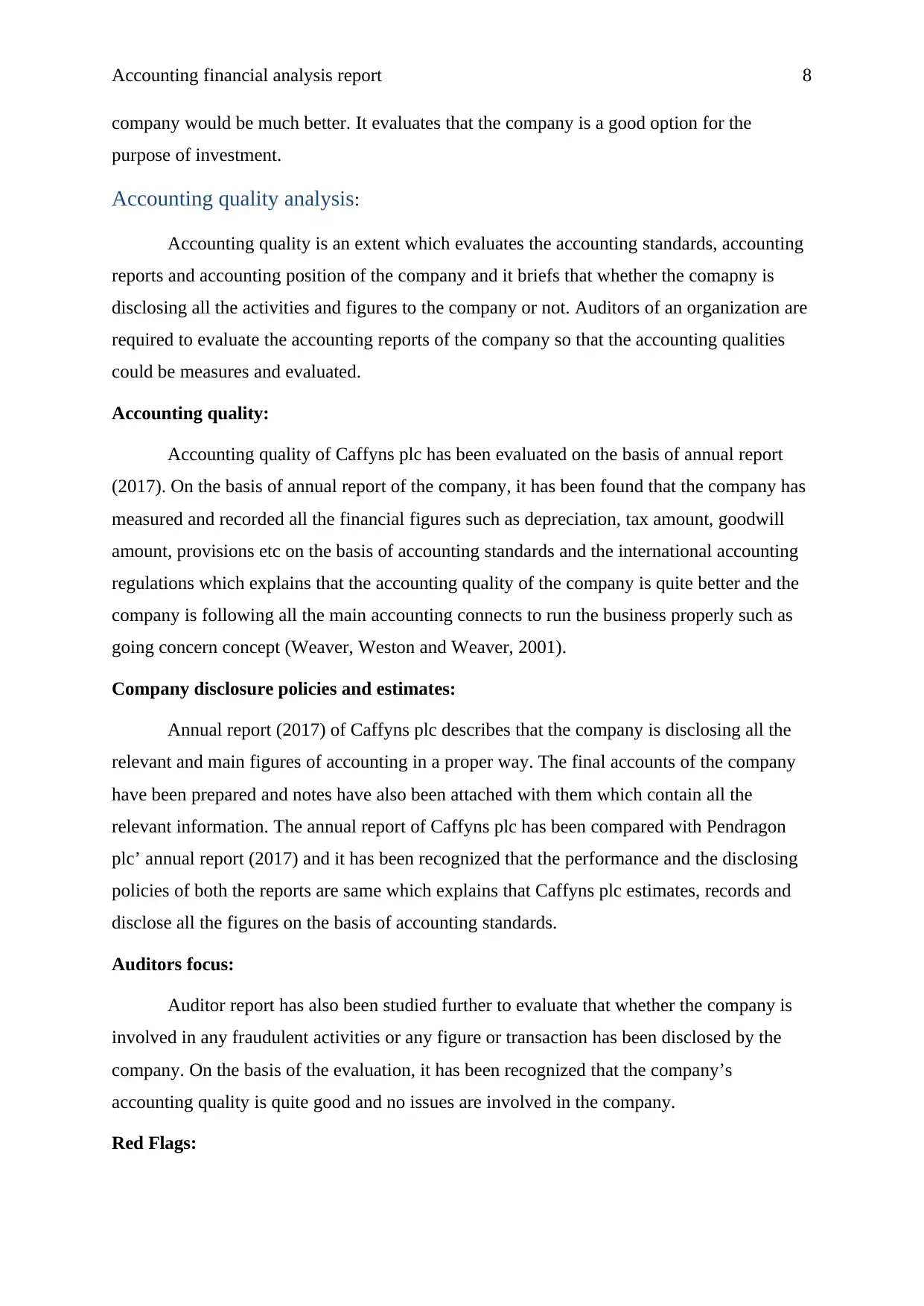
Accounting financial analysis report 8
company would be much better. It evaluates that the company is a good option for the
purpose of investment.
Accounting quality analysis:
Accounting quality is an extent which evaluates the accounting standards, accounting
reports and accounting position of the company and it briefs that whether the comapny is
disclosing all the activities and figures to the company or not. Auditors of an organization are
required to evaluate the accounting reports of the company so that the accounting qualities
could be measures and evaluated.
Accounting quality:
Accounting quality of Caffyns plc has been evaluated on the basis of annual report
(2017). On the basis of annual report of the company, it has been found that the company has
measured and recorded all the financial figures such as depreciation, tax amount, goodwill
amount, provisions etc on the basis of accounting standards and the international accounting
regulations which explains that the accounting quality of the company is quite better and the
company is following all the main accounting connects to run the business properly such as
going concern concept (Weaver, Weston and Weaver, 2001).
Company disclosure policies and estimates:
Annual report (2017) of Caffyns plc describes that the company is disclosing all the
relevant and main figures of accounting in a proper way. The final accounts of the company
have been prepared and notes have also been attached with them which contain all the
relevant information. The annual report of Caffyns plc has been compared with Pendragon
plc’ annual report (2017) and it has been recognized that the performance and the disclosing
policies of both the reports are same which explains that Caffyns plc estimates, records and
disclose all the figures on the basis of accounting standards.
Auditors focus:
Auditor report has also been studied further to evaluate that whether the company is
involved in any fraudulent activities or any figure or transaction has been disclosed by the
company. On the basis of the evaluation, it has been recognized that the company’s
accounting quality is quite good and no issues are involved in the company.
Red Flags:
company would be much better. It evaluates that the company is a good option for the
purpose of investment.
Accounting quality analysis:
Accounting quality is an extent which evaluates the accounting standards, accounting
reports and accounting position of the company and it briefs that whether the comapny is
disclosing all the activities and figures to the company or not. Auditors of an organization are
required to evaluate the accounting reports of the company so that the accounting qualities
could be measures and evaluated.
Accounting quality:
Accounting quality of Caffyns plc has been evaluated on the basis of annual report
(2017). On the basis of annual report of the company, it has been found that the company has
measured and recorded all the financial figures such as depreciation, tax amount, goodwill
amount, provisions etc on the basis of accounting standards and the international accounting
regulations which explains that the accounting quality of the company is quite better and the
company is following all the main accounting connects to run the business properly such as
going concern concept (Weaver, Weston and Weaver, 2001).
Company disclosure policies and estimates:
Annual report (2017) of Caffyns plc describes that the company is disclosing all the
relevant and main figures of accounting in a proper way. The final accounts of the company
have been prepared and notes have also been attached with them which contain all the
relevant information. The annual report of Caffyns plc has been compared with Pendragon
plc’ annual report (2017) and it has been recognized that the performance and the disclosing
policies of both the reports are same which explains that Caffyns plc estimates, records and
disclose all the figures on the basis of accounting standards.
Auditors focus:
Auditor report has also been studied further to evaluate that whether the company is
involved in any fraudulent activities or any figure or transaction has been disclosed by the
company. On the basis of the evaluation, it has been recognized that the company’s
accounting quality is quite good and no issues are involved in the company.
Red Flags:
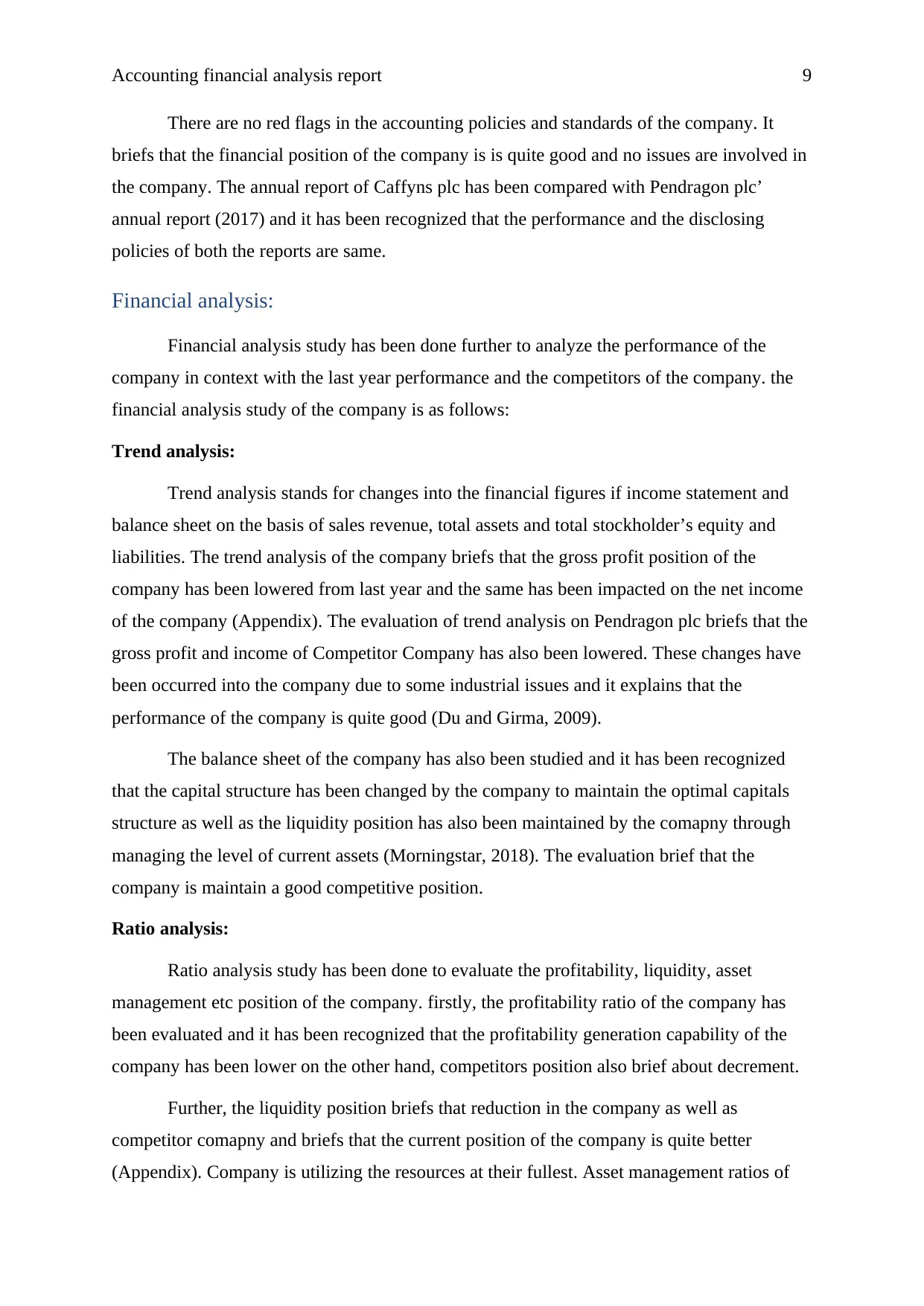
Accounting financial analysis report 9
There are no red flags in the accounting policies and standards of the company. It
briefs that the financial position of the company is is quite good and no issues are involved in
the company. The annual report of Caffyns plc has been compared with Pendragon plc’
annual report (2017) and it has been recognized that the performance and the disclosing
policies of both the reports are same.
Financial analysis:
Financial analysis study has been done further to analyze the performance of the
company in context with the last year performance and the competitors of the company. the
financial analysis study of the company is as follows:
Trend analysis:
Trend analysis stands for changes into the financial figures if income statement and
balance sheet on the basis of sales revenue, total assets and total stockholder’s equity and
liabilities. The trend analysis of the company briefs that the gross profit position of the
company has been lowered from last year and the same has been impacted on the net income
of the company (Appendix). The evaluation of trend analysis on Pendragon plc briefs that the
gross profit and income of Competitor Company has also been lowered. These changes have
been occurred into the company due to some industrial issues and it explains that the
performance of the company is quite good (Du and Girma, 2009).
The balance sheet of the company has also been studied and it has been recognized
that the capital structure has been changed by the company to maintain the optimal capitals
structure as well as the liquidity position has also been maintained by the comapny through
managing the level of current assets (Morningstar, 2018). The evaluation brief that the
company is maintain a good competitive position.
Ratio analysis:
Ratio analysis study has been done to evaluate the profitability, liquidity, asset
management etc position of the company. firstly, the profitability ratio of the company has
been evaluated and it has been recognized that the profitability generation capability of the
company has been lower on the other hand, competitors position also brief about decrement.
Further, the liquidity position briefs that reduction in the company as well as
competitor comapny and briefs that the current position of the company is quite better
(Appendix). Company is utilizing the resources at their fullest. Asset management ratios of
There are no red flags in the accounting policies and standards of the company. It
briefs that the financial position of the company is is quite good and no issues are involved in
the company. The annual report of Caffyns plc has been compared with Pendragon plc’
annual report (2017) and it has been recognized that the performance and the disclosing
policies of both the reports are same.
Financial analysis:
Financial analysis study has been done further to analyze the performance of the
company in context with the last year performance and the competitors of the company. the
financial analysis study of the company is as follows:
Trend analysis:
Trend analysis stands for changes into the financial figures if income statement and
balance sheet on the basis of sales revenue, total assets and total stockholder’s equity and
liabilities. The trend analysis of the company briefs that the gross profit position of the
company has been lowered from last year and the same has been impacted on the net income
of the company (Appendix). The evaluation of trend analysis on Pendragon plc briefs that the
gross profit and income of Competitor Company has also been lowered. These changes have
been occurred into the company due to some industrial issues and it explains that the
performance of the company is quite good (Du and Girma, 2009).
The balance sheet of the company has also been studied and it has been recognized
that the capital structure has been changed by the company to maintain the optimal capitals
structure as well as the liquidity position has also been maintained by the comapny through
managing the level of current assets (Morningstar, 2018). The evaluation brief that the
company is maintain a good competitive position.
Ratio analysis:
Ratio analysis study has been done to evaluate the profitability, liquidity, asset
management etc position of the company. firstly, the profitability ratio of the company has
been evaluated and it has been recognized that the profitability generation capability of the
company has been lower on the other hand, competitors position also brief about decrement.
Further, the liquidity position briefs that reduction in the company as well as
competitor comapny and briefs that the current position of the company is quite better
(Appendix). Company is utilizing the resources at their fullest. Asset management ratios of
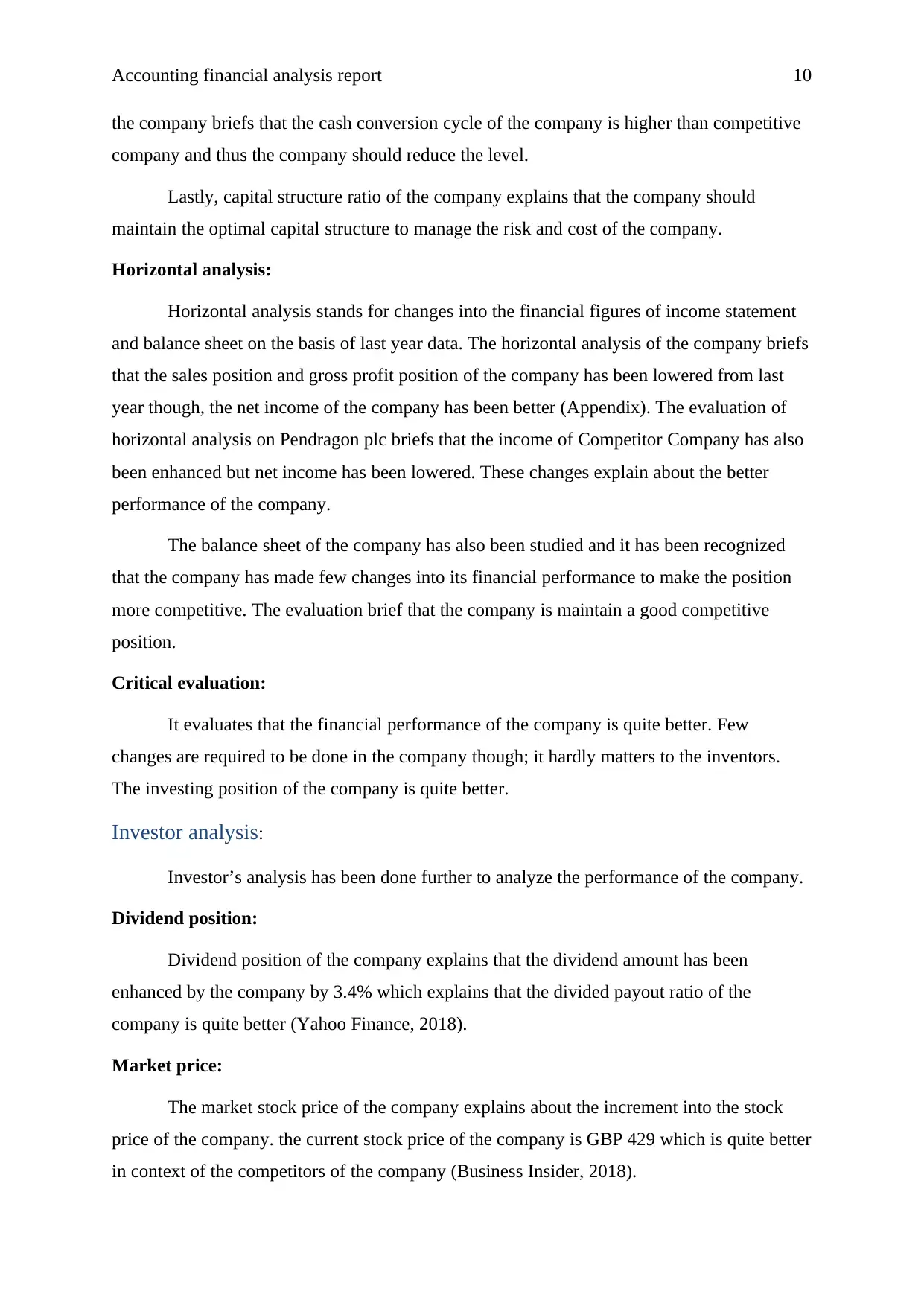
Accounting financial analysis report 10
the company briefs that the cash conversion cycle of the company is higher than competitive
company and thus the company should reduce the level.
Lastly, capital structure ratio of the company explains that the company should
maintain the optimal capital structure to manage the risk and cost of the company.
Horizontal analysis:
Horizontal analysis stands for changes into the financial figures of income statement
and balance sheet on the basis of last year data. The horizontal analysis of the company briefs
that the sales position and gross profit position of the company has been lowered from last
year though, the net income of the company has been better (Appendix). The evaluation of
horizontal analysis on Pendragon plc briefs that the income of Competitor Company has also
been enhanced but net income has been lowered. These changes explain about the better
performance of the company.
The balance sheet of the company has also been studied and it has been recognized
that the company has made few changes into its financial performance to make the position
more competitive. The evaluation brief that the company is maintain a good competitive
position.
Critical evaluation:
It evaluates that the financial performance of the company is quite better. Few
changes are required to be done in the company though; it hardly matters to the inventors.
The investing position of the company is quite better.
Investor analysis:
Investor’s analysis has been done further to analyze the performance of the company.
Dividend position:
Dividend position of the company explains that the dividend amount has been
enhanced by the company by 3.4% which explains that the divided payout ratio of the
company is quite better (Yahoo Finance, 2018).
Market price:
The market stock price of the company explains about the increment into the stock
price of the company. the current stock price of the company is GBP 429 which is quite better
in context of the competitors of the company (Business Insider, 2018).
the company briefs that the cash conversion cycle of the company is higher than competitive
company and thus the company should reduce the level.
Lastly, capital structure ratio of the company explains that the company should
maintain the optimal capital structure to manage the risk and cost of the company.
Horizontal analysis:
Horizontal analysis stands for changes into the financial figures of income statement
and balance sheet on the basis of last year data. The horizontal analysis of the company briefs
that the sales position and gross profit position of the company has been lowered from last
year though, the net income of the company has been better (Appendix). The evaluation of
horizontal analysis on Pendragon plc briefs that the income of Competitor Company has also
been enhanced but net income has been lowered. These changes explain about the better
performance of the company.
The balance sheet of the company has also been studied and it has been recognized
that the company has made few changes into its financial performance to make the position
more competitive. The evaluation brief that the company is maintain a good competitive
position.
Critical evaluation:
It evaluates that the financial performance of the company is quite better. Few
changes are required to be done in the company though; it hardly matters to the inventors.
The investing position of the company is quite better.
Investor analysis:
Investor’s analysis has been done further to analyze the performance of the company.
Dividend position:
Dividend position of the company explains that the dividend amount has been
enhanced by the company by 3.4% which explains that the divided payout ratio of the
company is quite better (Yahoo Finance, 2018).
Market price:
The market stock price of the company explains about the increment into the stock
price of the company. the current stock price of the company is GBP 429 which is quite better
in context of the competitors of the company (Business Insider, 2018).
Secure Best Marks with AI Grader
Need help grading? Try our AI Grader for instant feedback on your assignments.
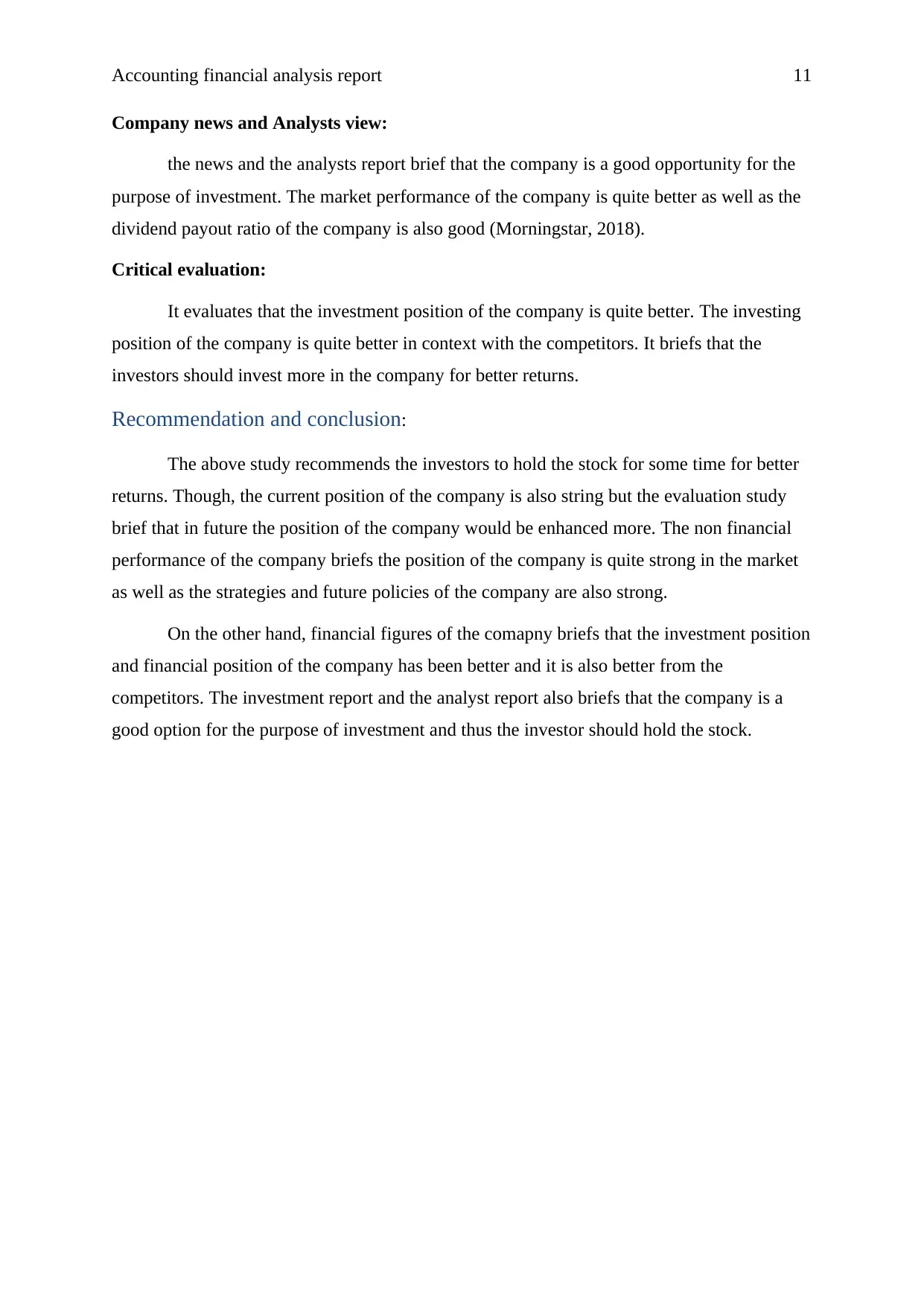
Accounting financial analysis report 11
Company news and Analysts view:
the news and the analysts report brief that the company is a good opportunity for the
purpose of investment. The market performance of the company is quite better as well as the
dividend payout ratio of the company is also good (Morningstar, 2018).
Critical evaluation:
It evaluates that the investment position of the company is quite better. The investing
position of the company is quite better in context with the competitors. It briefs that the
investors should invest more in the company for better returns.
Recommendation and conclusion:
The above study recommends the investors to hold the stock for some time for better
returns. Though, the current position of the company is also string but the evaluation study
brief that in future the position of the company would be enhanced more. The non financial
performance of the company briefs the position of the company is quite strong in the market
as well as the strategies and future policies of the company are also strong.
On the other hand, financial figures of the comapny briefs that the investment position
and financial position of the company has been better and it is also better from the
competitors. The investment report and the analyst report also briefs that the company is a
good option for the purpose of investment and thus the investor should hold the stock.
Company news and Analysts view:
the news and the analysts report brief that the company is a good opportunity for the
purpose of investment. The market performance of the company is quite better as well as the
dividend payout ratio of the company is also good (Morningstar, 2018).
Critical evaluation:
It evaluates that the investment position of the company is quite better. The investing
position of the company is quite better in context with the competitors. It briefs that the
investors should invest more in the company for better returns.
Recommendation and conclusion:
The above study recommends the investors to hold the stock for some time for better
returns. Though, the current position of the company is also string but the evaluation study
brief that in future the position of the company would be enhanced more. The non financial
performance of the company briefs the position of the company is quite strong in the market
as well as the strategies and future policies of the company are also strong.
On the other hand, financial figures of the comapny briefs that the investment position
and financial position of the company has been better and it is also better from the
competitors. The investment report and the analyst report also briefs that the company is a
good option for the purpose of investment and thus the investor should hold the stock.
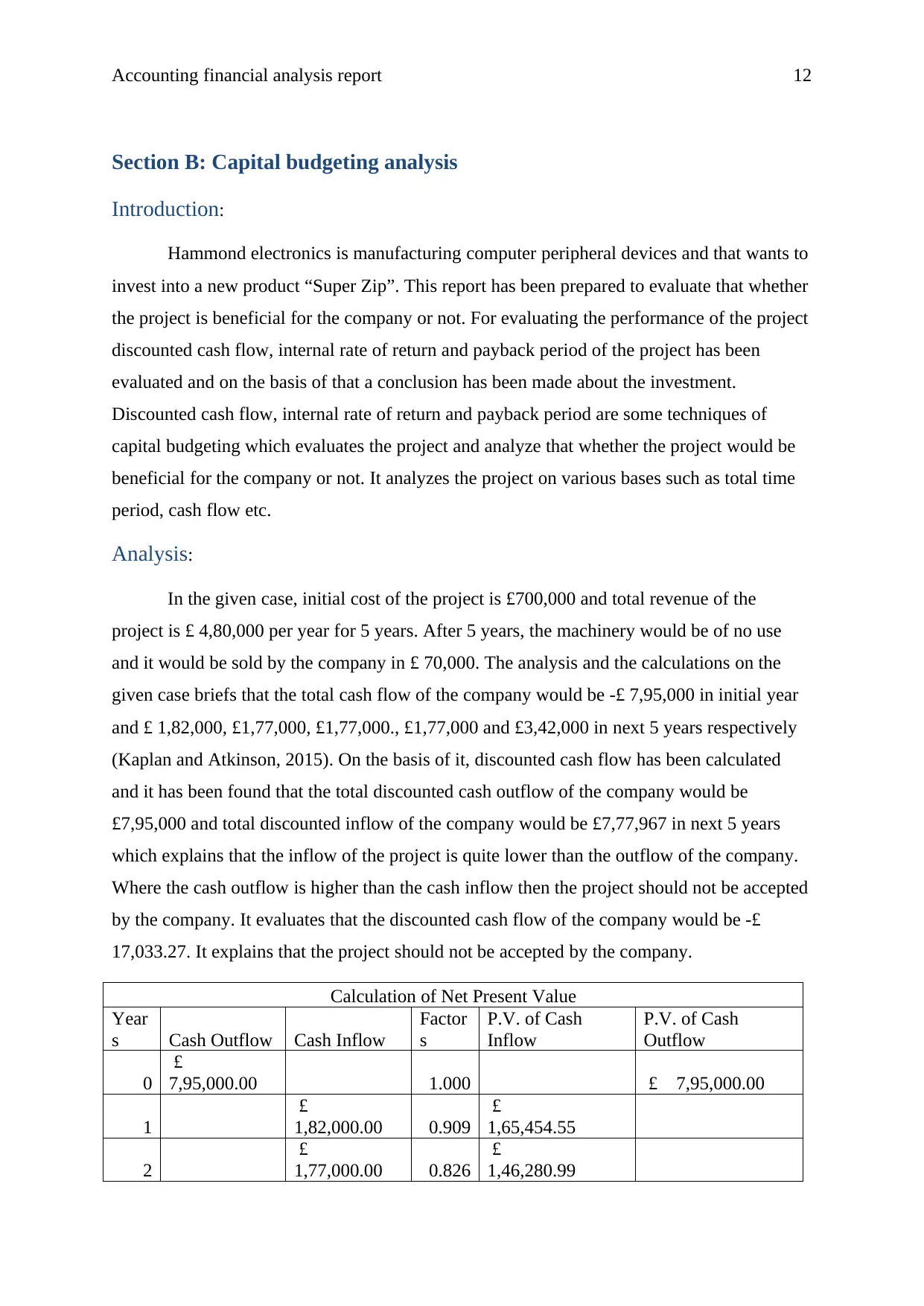
Accounting financial analysis report 12
Section B: Capital budgeting analysis
Introduction:
Hammond electronics is manufacturing computer peripheral devices and that wants to
invest into a new product “Super Zip”. This report has been prepared to evaluate that whether
the project is beneficial for the company or not. For evaluating the performance of the project
discounted cash flow, internal rate of return and payback period of the project has been
evaluated and on the basis of that a conclusion has been made about the investment.
Discounted cash flow, internal rate of return and payback period are some techniques of
capital budgeting which evaluates the project and analyze that whether the project would be
beneficial for the company or not. It analyzes the project on various bases such as total time
period, cash flow etc.
Analysis:
In the given case, initial cost of the project is £700,000 and total revenue of the
project is £ 4,80,000 per year for 5 years. After 5 years, the machinery would be of no use
and it would be sold by the company in £ 70,000. The analysis and the calculations on the
given case briefs that the total cash flow of the company would be -£ 7,95,000 in initial year
and £ 1,82,000, £1,77,000, £1,77,000., £1,77,000 and £3,42,000 in next 5 years respectively
(Kaplan and Atkinson, 2015). On the basis of it, discounted cash flow has been calculated
and it has been found that the total discounted cash outflow of the company would be
£7,95,000 and total discounted inflow of the company would be £7,77,967 in next 5 years
which explains that the inflow of the project is quite lower than the outflow of the company.
Where the cash outflow is higher than the cash inflow then the project should not be accepted
by the company. It evaluates that the discounted cash flow of the company would be -£
17,033.27. It explains that the project should not be accepted by the company.
Calculation of Net Present Value
Year
s Cash Outflow Cash Inflow
Factor
s
P.V. of Cash
Inflow
P.V. of Cash
Outflow
0
£
7,95,000.00 1.000 £ 7,95,000.00
1
£
1,82,000.00 0.909
£
1,65,454.55
2
£
1,77,000.00 0.826
£
1,46,280.99
Section B: Capital budgeting analysis
Introduction:
Hammond electronics is manufacturing computer peripheral devices and that wants to
invest into a new product “Super Zip”. This report has been prepared to evaluate that whether
the project is beneficial for the company or not. For evaluating the performance of the project
discounted cash flow, internal rate of return and payback period of the project has been
evaluated and on the basis of that a conclusion has been made about the investment.
Discounted cash flow, internal rate of return and payback period are some techniques of
capital budgeting which evaluates the project and analyze that whether the project would be
beneficial for the company or not. It analyzes the project on various bases such as total time
period, cash flow etc.
Analysis:
In the given case, initial cost of the project is £700,000 and total revenue of the
project is £ 4,80,000 per year for 5 years. After 5 years, the machinery would be of no use
and it would be sold by the company in £ 70,000. The analysis and the calculations on the
given case briefs that the total cash flow of the company would be -£ 7,95,000 in initial year
and £ 1,82,000, £1,77,000, £1,77,000., £1,77,000 and £3,42,000 in next 5 years respectively
(Kaplan and Atkinson, 2015). On the basis of it, discounted cash flow has been calculated
and it has been found that the total discounted cash outflow of the company would be
£7,95,000 and total discounted inflow of the company would be £7,77,967 in next 5 years
which explains that the inflow of the project is quite lower than the outflow of the company.
Where the cash outflow is higher than the cash inflow then the project should not be accepted
by the company. It evaluates that the discounted cash flow of the company would be -£
17,033.27. It explains that the project should not be accepted by the company.
Calculation of Net Present Value
Year
s Cash Outflow Cash Inflow
Factor
s
P.V. of Cash
Inflow
P.V. of Cash
Outflow
0
£
7,95,000.00 1.000 £ 7,95,000.00
1
£
1,82,000.00 0.909
£
1,65,454.55
2
£
1,77,000.00 0.826
£
1,46,280.99
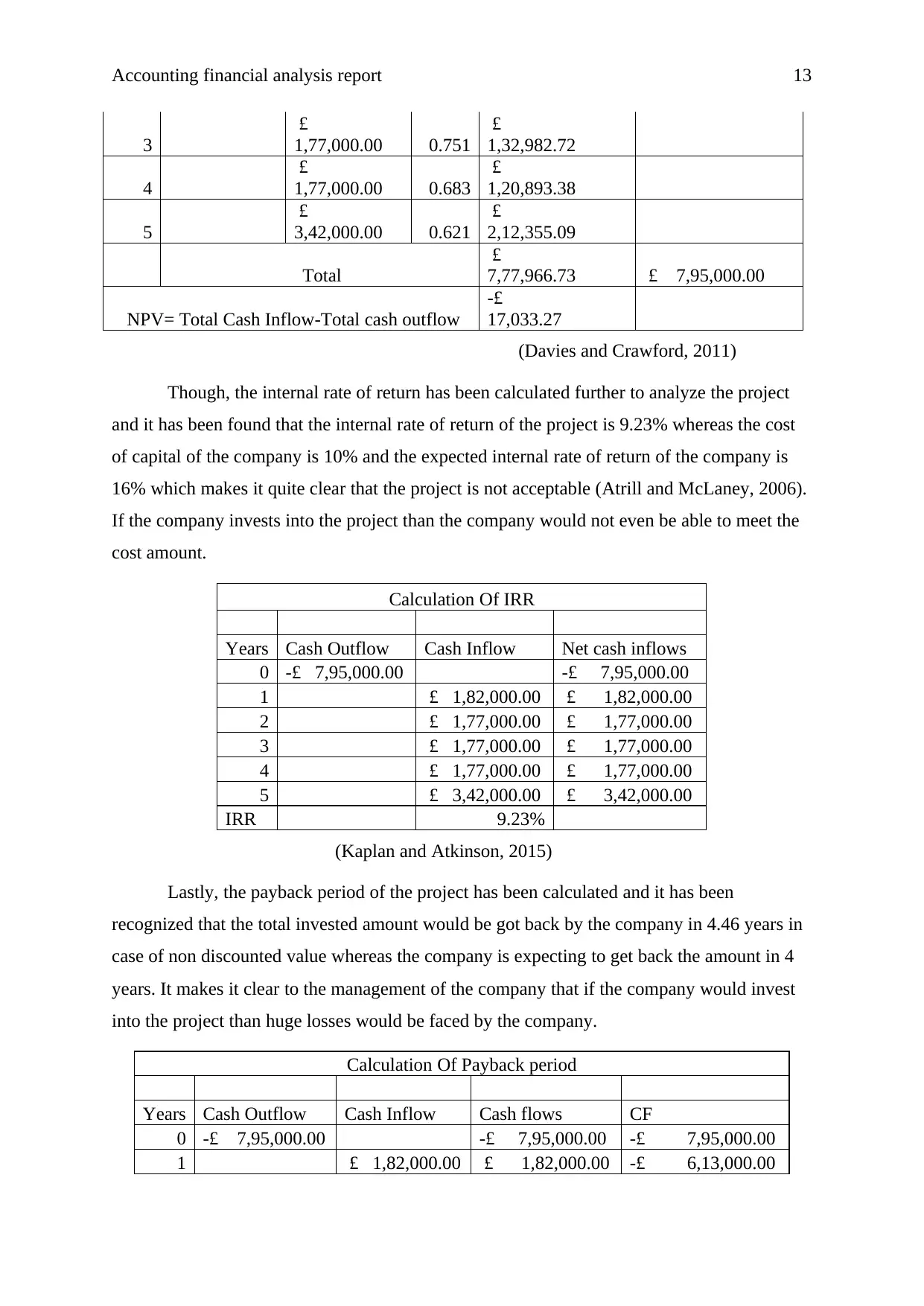
Accounting financial analysis report 13
3
£
1,77,000.00 0.751
£
1,32,982.72
4
£
1,77,000.00 0.683
£
1,20,893.38
5
£
3,42,000.00 0.621
£
2,12,355.09
Total
£
7,77,966.73 £ 7,95,000.00
NPV= Total Cash Inflow-Total cash outflow
-£
17,033.27
(Davies and Crawford, 2011)
Though, the internal rate of return has been calculated further to analyze the project
and it has been found that the internal rate of return of the project is 9.23% whereas the cost
of capital of the company is 10% and the expected internal rate of return of the company is
16% which makes it quite clear that the project is not acceptable (Atrill and McLaney, 2006).
If the company invests into the project than the company would not even be able to meet the
cost amount.
Calculation Of IRR
Years Cash Outflow Cash Inflow Net cash inflows
0 -£ 7,95,000.00 -£ 7,95,000.00
1 £ 1,82,000.00 £ 1,82,000.00
2 £ 1,77,000.00 £ 1,77,000.00
3 £ 1,77,000.00 £ 1,77,000.00
4 £ 1,77,000.00 £ 1,77,000.00
5 £ 3,42,000.00 £ 3,42,000.00
IRR 9.23%
(Kaplan and Atkinson, 2015)
Lastly, the payback period of the project has been calculated and it has been
recognized that the total invested amount would be got back by the company in 4.46 years in
case of non discounted value whereas the company is expecting to get back the amount in 4
years. It makes it clear to the management of the company that if the company would invest
into the project than huge losses would be faced by the company.
Calculation Of Payback period
Years Cash Outflow Cash Inflow Cash flows CF
0 -£ 7,95,000.00 -£ 7,95,000.00 -£ 7,95,000.00
1 £ 1,82,000.00 £ 1,82,000.00 -£ 6,13,000.00
3
£
1,77,000.00 0.751
£
1,32,982.72
4
£
1,77,000.00 0.683
£
1,20,893.38
5
£
3,42,000.00 0.621
£
2,12,355.09
Total
£
7,77,966.73 £ 7,95,000.00
NPV= Total Cash Inflow-Total cash outflow
-£
17,033.27
(Davies and Crawford, 2011)
Though, the internal rate of return has been calculated further to analyze the project
and it has been found that the internal rate of return of the project is 9.23% whereas the cost
of capital of the company is 10% and the expected internal rate of return of the company is
16% which makes it quite clear that the project is not acceptable (Atrill and McLaney, 2006).
If the company invests into the project than the company would not even be able to meet the
cost amount.
Calculation Of IRR
Years Cash Outflow Cash Inflow Net cash inflows
0 -£ 7,95,000.00 -£ 7,95,000.00
1 £ 1,82,000.00 £ 1,82,000.00
2 £ 1,77,000.00 £ 1,77,000.00
3 £ 1,77,000.00 £ 1,77,000.00
4 £ 1,77,000.00 £ 1,77,000.00
5 £ 3,42,000.00 £ 3,42,000.00
IRR 9.23%
(Kaplan and Atkinson, 2015)
Lastly, the payback period of the project has been calculated and it has been
recognized that the total invested amount would be got back by the company in 4.46 years in
case of non discounted value whereas the company is expecting to get back the amount in 4
years. It makes it clear to the management of the company that if the company would invest
into the project than huge losses would be faced by the company.
Calculation Of Payback period
Years Cash Outflow Cash Inflow Cash flows CF
0 -£ 7,95,000.00 -£ 7,95,000.00 -£ 7,95,000.00
1 £ 1,82,000.00 £ 1,82,000.00 -£ 6,13,000.00
Paraphrase This Document
Need a fresh take? Get an instant paraphrase of this document with our AI Paraphraser
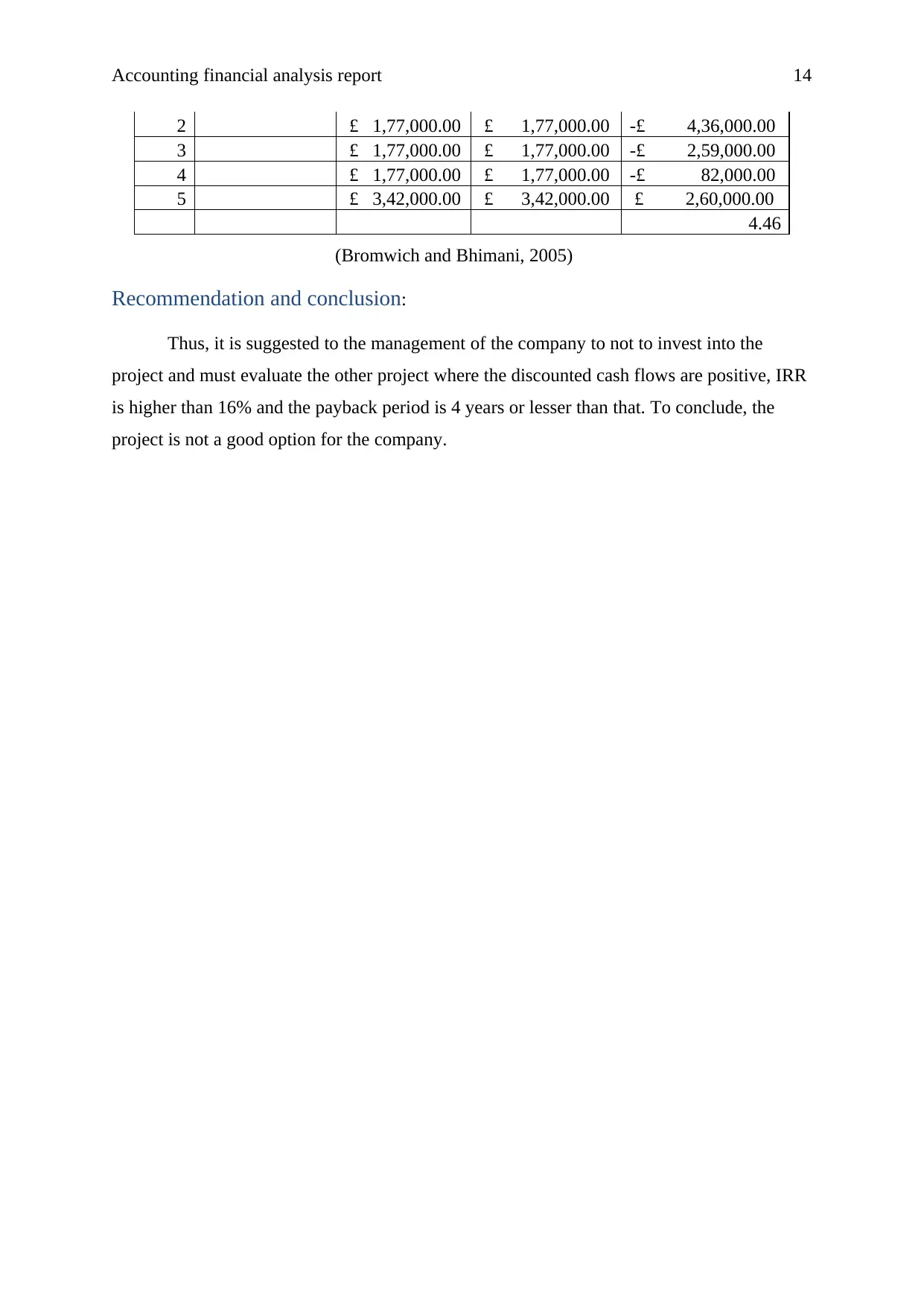
Accounting financial analysis report 14
2 £ 1,77,000.00 £ 1,77,000.00 -£ 4,36,000.00
3 £ 1,77,000.00 £ 1,77,000.00 -£ 2,59,000.00
4 £ 1,77,000.00 £ 1,77,000.00 -£ 82,000.00
5 £ 3,42,000.00 £ 3,42,000.00 £ 2,60,000.00
4.46
(Bromwich and Bhimani, 2005)
Recommendation and conclusion:
Thus, it is suggested to the management of the company to not to invest into the
project and must evaluate the other project where the discounted cash flows are positive, IRR
is higher than 16% and the payback period is 4 years or lesser than that. To conclude, the
project is not a good option for the company.
2 £ 1,77,000.00 £ 1,77,000.00 -£ 4,36,000.00
3 £ 1,77,000.00 £ 1,77,000.00 -£ 2,59,000.00
4 £ 1,77,000.00 £ 1,77,000.00 -£ 82,000.00
5 £ 3,42,000.00 £ 3,42,000.00 £ 2,60,000.00
4.46
(Bromwich and Bhimani, 2005)
Recommendation and conclusion:
Thus, it is suggested to the management of the company to not to invest into the
project and must evaluate the other project where the discounted cash flows are positive, IRR
is higher than 16% and the payback period is 4 years or lesser than that. To conclude, the
project is not a good option for the company.
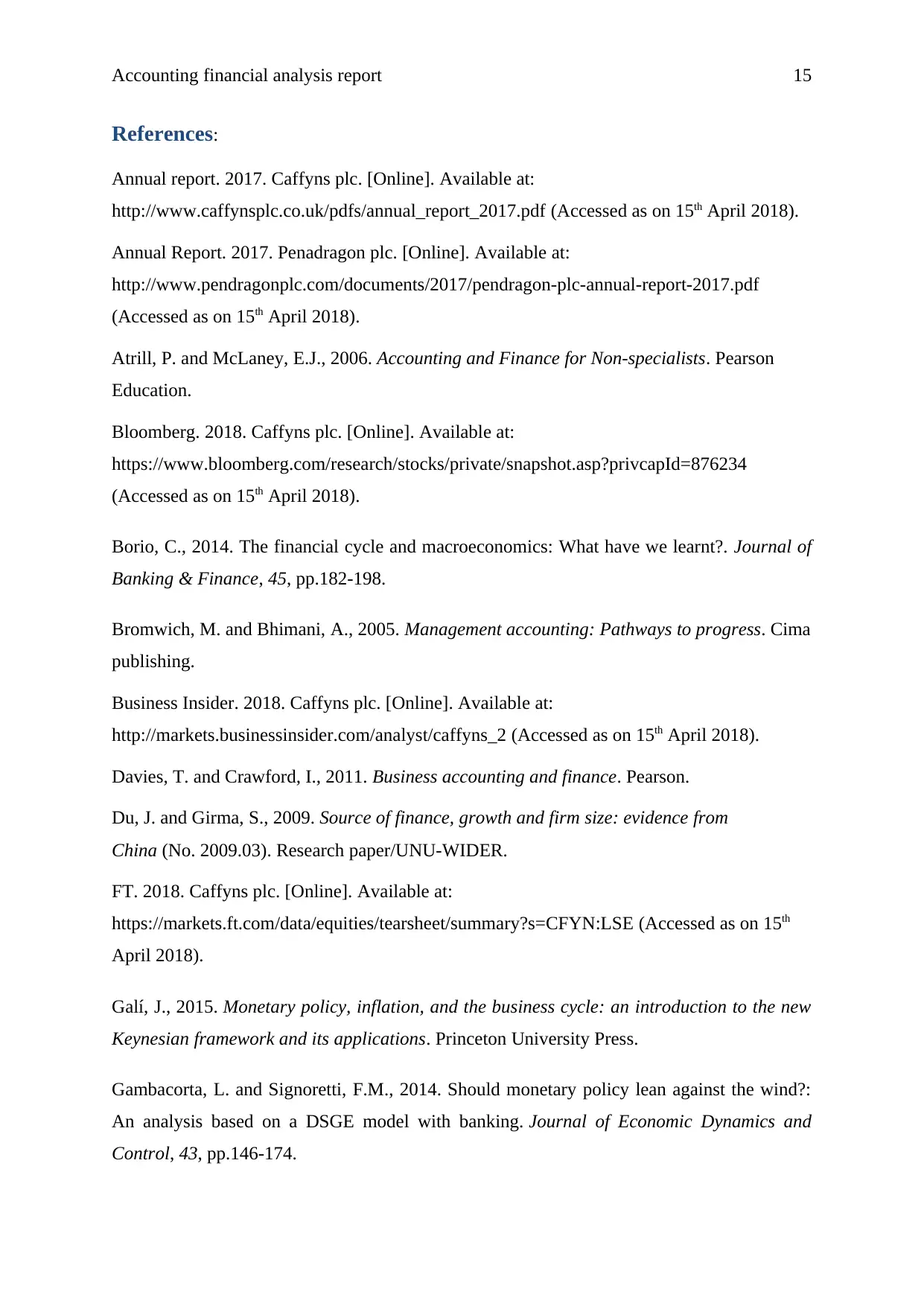
Accounting financial analysis report 15
References:
Annual report. 2017. Caffyns plc. [Online]. Available at:
http://www.caffynsplc.co.uk/pdfs/annual_report_2017.pdf (Accessed as on 15th April 2018).
Annual Report. 2017. Penadragon plc. [Online]. Available at:
http://www.pendragonplc.com/documents/2017/pendragon-plc-annual-report-2017.pdf
(Accessed as on 15th April 2018).
Atrill, P. and McLaney, E.J., 2006. Accounting and Finance for Non-specialists. Pearson
Education.
Bloomberg. 2018. Caffyns plc. [Online]. Available at:
https://www.bloomberg.com/research/stocks/private/snapshot.asp?privcapId=876234
(Accessed as on 15th April 2018).
Borio, C., 2014. The financial cycle and macroeconomics: What have we learnt?. Journal of
Banking & Finance, 45, pp.182-198.
Bromwich, M. and Bhimani, A., 2005. Management accounting: Pathways to progress. Cima
publishing.
Business Insider. 2018. Caffyns plc. [Online]. Available at:
http://markets.businessinsider.com/analyst/caffyns_2 (Accessed as on 15th April 2018).
Davies, T. and Crawford, I., 2011. Business accounting and finance. Pearson.
Du, J. and Girma, S., 2009. Source of finance, growth and firm size: evidence from
China (No. 2009.03). Research paper/UNU-WIDER.
FT. 2018. Caffyns plc. [Online]. Available at:
https://markets.ft.com/data/equities/tearsheet/summary?s=CFYN:LSE (Accessed as on 15th
April 2018).
Galí, J., 2015. Monetary policy, inflation, and the business cycle: an introduction to the new
Keynesian framework and its applications. Princeton University Press.
Gambacorta, L. and Signoretti, F.M., 2014. Should monetary policy lean against the wind?:
An analysis based on a DSGE model with banking. Journal of Economic Dynamics and
Control, 43, pp.146-174.
References:
Annual report. 2017. Caffyns plc. [Online]. Available at:
http://www.caffynsplc.co.uk/pdfs/annual_report_2017.pdf (Accessed as on 15th April 2018).
Annual Report. 2017. Penadragon plc. [Online]. Available at:
http://www.pendragonplc.com/documents/2017/pendragon-plc-annual-report-2017.pdf
(Accessed as on 15th April 2018).
Atrill, P. and McLaney, E.J., 2006. Accounting and Finance for Non-specialists. Pearson
Education.
Bloomberg. 2018. Caffyns plc. [Online]. Available at:
https://www.bloomberg.com/research/stocks/private/snapshot.asp?privcapId=876234
(Accessed as on 15th April 2018).
Borio, C., 2014. The financial cycle and macroeconomics: What have we learnt?. Journal of
Banking & Finance, 45, pp.182-198.
Bromwich, M. and Bhimani, A., 2005. Management accounting: Pathways to progress. Cima
publishing.
Business Insider. 2018. Caffyns plc. [Online]. Available at:
http://markets.businessinsider.com/analyst/caffyns_2 (Accessed as on 15th April 2018).
Davies, T. and Crawford, I., 2011. Business accounting and finance. Pearson.
Du, J. and Girma, S., 2009. Source of finance, growth and firm size: evidence from
China (No. 2009.03). Research paper/UNU-WIDER.
FT. 2018. Caffyns plc. [Online]. Available at:
https://markets.ft.com/data/equities/tearsheet/summary?s=CFYN:LSE (Accessed as on 15th
April 2018).
Galí, J., 2015. Monetary policy, inflation, and the business cycle: an introduction to the new
Keynesian framework and its applications. Princeton University Press.
Gambacorta, L. and Signoretti, F.M., 2014. Should monetary policy lean against the wind?:
An analysis based on a DSGE model with banking. Journal of Economic Dynamics and
Control, 43, pp.146-174.
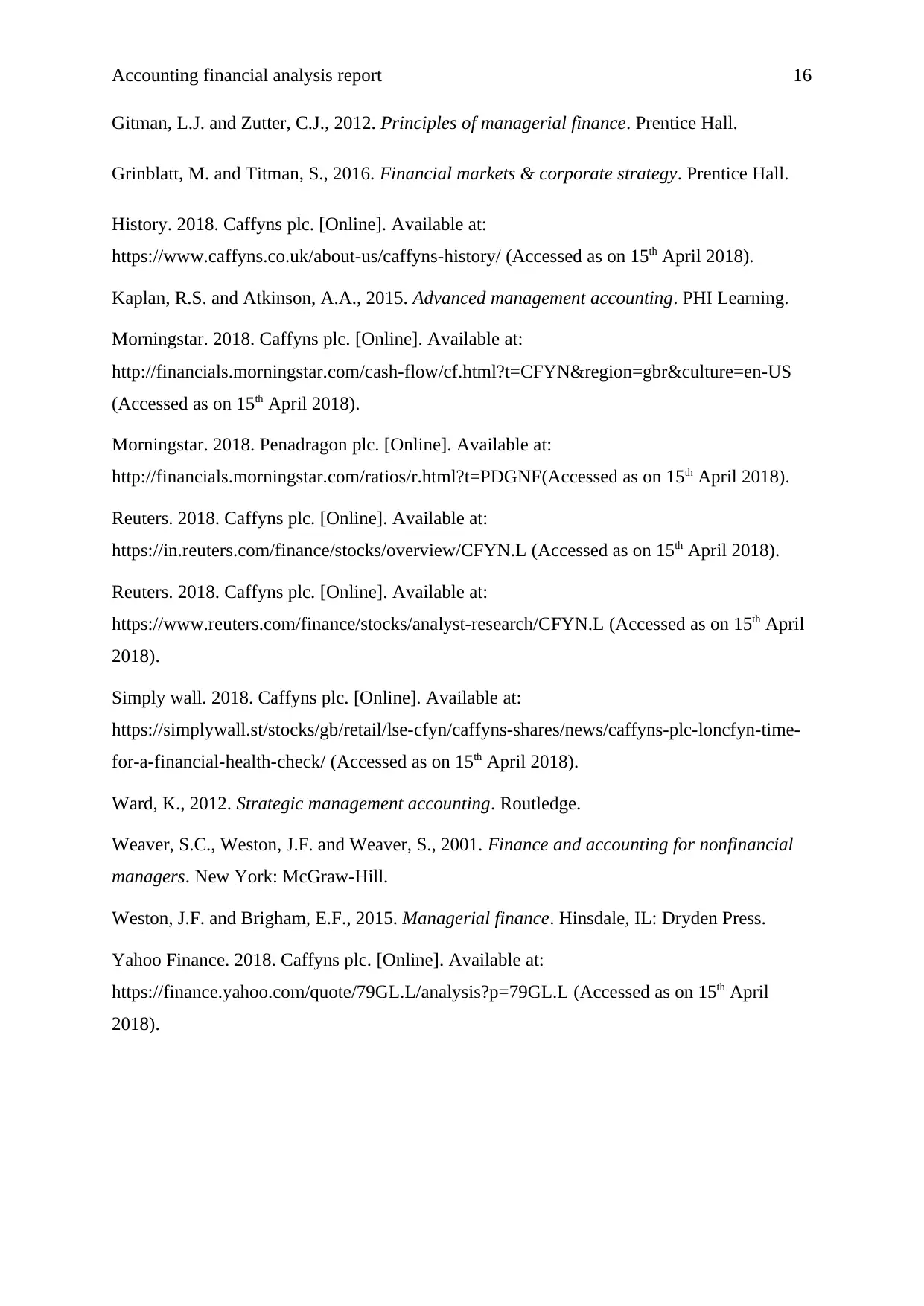
Accounting financial analysis report 16
Gitman, L.J. and Zutter, C.J., 2012. Principles of managerial finance. Prentice Hall.
Grinblatt, M. and Titman, S., 2016. Financial markets & corporate strategy. Prentice Hall.
History. 2018. Caffyns plc. [Online]. Available at:
https://www.caffyns.co.uk/about-us/caffyns-history/ (Accessed as on 15th April 2018).
Kaplan, R.S. and Atkinson, A.A., 2015. Advanced management accounting. PHI Learning.
Morningstar. 2018. Caffyns plc. [Online]. Available at:
http://financials.morningstar.com/cash-flow/cf.html?t=CFYN®ion=gbr&culture=en-US
(Accessed as on 15th April 2018).
Morningstar. 2018. Penadragon plc. [Online]. Available at:
http://financials.morningstar.com/ratios/r.html?t=PDGNF(Accessed as on 15th April 2018).
Reuters. 2018. Caffyns plc. [Online]. Available at:
https://in.reuters.com/finance/stocks/overview/CFYN.L (Accessed as on 15th April 2018).
Reuters. 2018. Caffyns plc. [Online]. Available at:
https://www.reuters.com/finance/stocks/analyst-research/CFYN.L (Accessed as on 15th April
2018).
Simply wall. 2018. Caffyns plc. [Online]. Available at:
https://simplywall.st/stocks/gb/retail/lse-cfyn/caffyns-shares/news/caffyns-plc-loncfyn-time-
for-a-financial-health-check/ (Accessed as on 15th April 2018).
Ward, K., 2012. Strategic management accounting. Routledge.
Weaver, S.C., Weston, J.F. and Weaver, S., 2001. Finance and accounting for nonfinancial
managers. New York: McGraw-Hill.
Weston, J.F. and Brigham, E.F., 2015. Managerial finance. Hinsdale, IL: Dryden Press.
Yahoo Finance. 2018. Caffyns plc. [Online]. Available at:
https://finance.yahoo.com/quote/79GL.L/analysis?p=79GL.L (Accessed as on 15th April
2018).
Gitman, L.J. and Zutter, C.J., 2012. Principles of managerial finance. Prentice Hall.
Grinblatt, M. and Titman, S., 2016. Financial markets & corporate strategy. Prentice Hall.
History. 2018. Caffyns plc. [Online]. Available at:
https://www.caffyns.co.uk/about-us/caffyns-history/ (Accessed as on 15th April 2018).
Kaplan, R.S. and Atkinson, A.A., 2015. Advanced management accounting. PHI Learning.
Morningstar. 2018. Caffyns plc. [Online]. Available at:
http://financials.morningstar.com/cash-flow/cf.html?t=CFYN®ion=gbr&culture=en-US
(Accessed as on 15th April 2018).
Morningstar. 2018. Penadragon plc. [Online]. Available at:
http://financials.morningstar.com/ratios/r.html?t=PDGNF(Accessed as on 15th April 2018).
Reuters. 2018. Caffyns plc. [Online]. Available at:
https://in.reuters.com/finance/stocks/overview/CFYN.L (Accessed as on 15th April 2018).
Reuters. 2018. Caffyns plc. [Online]. Available at:
https://www.reuters.com/finance/stocks/analyst-research/CFYN.L (Accessed as on 15th April
2018).
Simply wall. 2018. Caffyns plc. [Online]. Available at:
https://simplywall.st/stocks/gb/retail/lse-cfyn/caffyns-shares/news/caffyns-plc-loncfyn-time-
for-a-financial-health-check/ (Accessed as on 15th April 2018).
Ward, K., 2012. Strategic management accounting. Routledge.
Weaver, S.C., Weston, J.F. and Weaver, S., 2001. Finance and accounting for nonfinancial
managers. New York: McGraw-Hill.
Weston, J.F. and Brigham, E.F., 2015. Managerial finance. Hinsdale, IL: Dryden Press.
Yahoo Finance. 2018. Caffyns plc. [Online]. Available at:
https://finance.yahoo.com/quote/79GL.L/analysis?p=79GL.L (Accessed as on 15th April
2018).
Secure Best Marks with AI Grader
Need help grading? Try our AI Grader for instant feedback on your assignments.
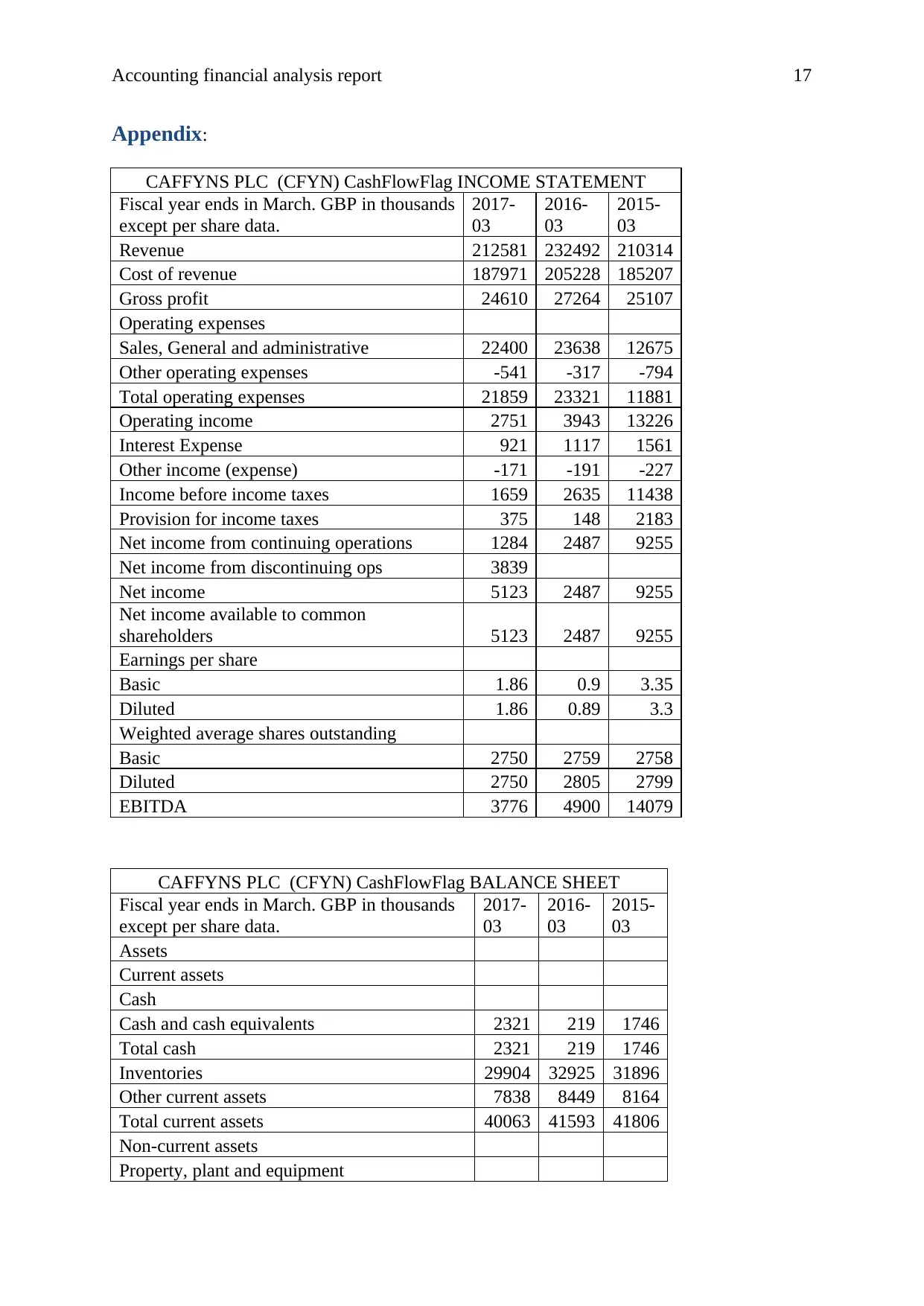
Accounting financial analysis report 17
Appendix:
CAFFYNS PLC (CFYN) CashFlowFlag INCOME STATEMENT
Fiscal year ends in March. GBP in thousands
except per share data.
2017-
03
2016-
03
2015-
03
Revenue 212581 232492 210314
Cost of revenue 187971 205228 185207
Gross profit 24610 27264 25107
Operating expenses
Sales, General and administrative 22400 23638 12675
Other operating expenses -541 -317 -794
Total operating expenses 21859 23321 11881
Operating income 2751 3943 13226
Interest Expense 921 1117 1561
Other income (expense) -171 -191 -227
Income before income taxes 1659 2635 11438
Provision for income taxes 375 148 2183
Net income from continuing operations 1284 2487 9255
Net income from discontinuing ops 3839
Net income 5123 2487 9255
Net income available to common
shareholders 5123 2487 9255
Earnings per share
Basic 1.86 0.9 3.35
Diluted 1.86 0.89 3.3
Weighted average shares outstanding
Basic 2750 2759 2758
Diluted 2750 2805 2799
EBITDA 3776 4900 14079
CAFFYNS PLC (CFYN) CashFlowFlag BALANCE SHEET
Fiscal year ends in March. GBP in thousands
except per share data.
2017-
03
2016-
03
2015-
03
Assets
Current assets
Cash
Cash and cash equivalents 2321 219 1746
Total cash 2321 219 1746
Inventories 29904 32925 31896
Other current assets 7838 8449 8164
Total current assets 40063 41593 41806
Non-current assets
Property, plant and equipment
Appendix:
CAFFYNS PLC (CFYN) CashFlowFlag INCOME STATEMENT
Fiscal year ends in March. GBP in thousands
except per share data.
2017-
03
2016-
03
2015-
03
Revenue 212581 232492 210314
Cost of revenue 187971 205228 185207
Gross profit 24610 27264 25107
Operating expenses
Sales, General and administrative 22400 23638 12675
Other operating expenses -541 -317 -794
Total operating expenses 21859 23321 11881
Operating income 2751 3943 13226
Interest Expense 921 1117 1561
Other income (expense) -171 -191 -227
Income before income taxes 1659 2635 11438
Provision for income taxes 375 148 2183
Net income from continuing operations 1284 2487 9255
Net income from discontinuing ops 3839
Net income 5123 2487 9255
Net income available to common
shareholders 5123 2487 9255
Earnings per share
Basic 1.86 0.9 3.35
Diluted 1.86 0.89 3.3
Weighted average shares outstanding
Basic 2750 2759 2758
Diluted 2750 2805 2799
EBITDA 3776 4900 14079
CAFFYNS PLC (CFYN) CashFlowFlag BALANCE SHEET
Fiscal year ends in March. GBP in thousands
except per share data.
2017-
03
2016-
03
2015-
03
Assets
Current assets
Cash
Cash and cash equivalents 2321 219 1746
Total cash 2321 219 1746
Inventories 29904 32925 31896
Other current assets 7838 8449 8164
Total current assets 40063 41593 41806
Non-current assets
Property, plant and equipment
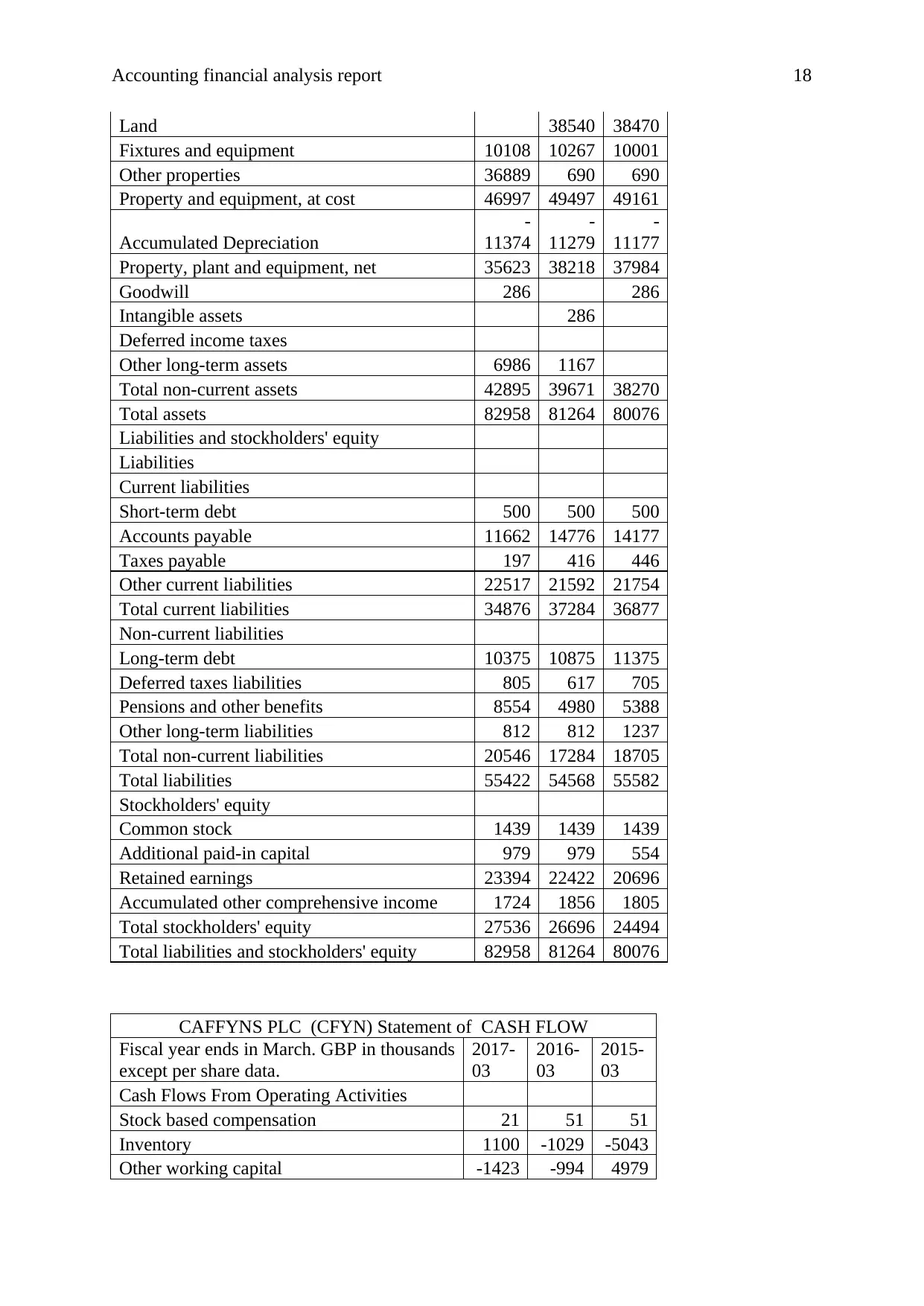
Accounting financial analysis report 18
Land 38540 38470
Fixtures and equipment 10108 10267 10001
Other properties 36889 690 690
Property and equipment, at cost 46997 49497 49161
Accumulated Depreciation
-
11374
-
11279
-
11177
Property, plant and equipment, net 35623 38218 37984
Goodwill 286 286
Intangible assets 286
Deferred income taxes
Other long-term assets 6986 1167
Total non-current assets 42895 39671 38270
Total assets 82958 81264 80076
Liabilities and stockholders' equity
Liabilities
Current liabilities
Short-term debt 500 500 500
Accounts payable 11662 14776 14177
Taxes payable 197 416 446
Other current liabilities 22517 21592 21754
Total current liabilities 34876 37284 36877
Non-current liabilities
Long-term debt 10375 10875 11375
Deferred taxes liabilities 805 617 705
Pensions and other benefits 8554 4980 5388
Other long-term liabilities 812 812 1237
Total non-current liabilities 20546 17284 18705
Total liabilities 55422 54568 55582
Stockholders' equity
Common stock 1439 1439 1439
Additional paid-in capital 979 979 554
Retained earnings 23394 22422 20696
Accumulated other comprehensive income 1724 1856 1805
Total stockholders' equity 27536 26696 24494
Total liabilities and stockholders' equity 82958 81264 80076
CAFFYNS PLC (CFYN) Statement of CASH FLOW
Fiscal year ends in March. GBP in thousands
except per share data.
2017-
03
2016-
03
2015-
03
Cash Flows From Operating Activities
Stock based compensation 21 51 51
Inventory 1100 -1029 -5043
Other working capital -1423 -994 4979
Land 38540 38470
Fixtures and equipment 10108 10267 10001
Other properties 36889 690 690
Property and equipment, at cost 46997 49497 49161
Accumulated Depreciation
-
11374
-
11279
-
11177
Property, plant and equipment, net 35623 38218 37984
Goodwill 286 286
Intangible assets 286
Deferred income taxes
Other long-term assets 6986 1167
Total non-current assets 42895 39671 38270
Total assets 82958 81264 80076
Liabilities and stockholders' equity
Liabilities
Current liabilities
Short-term debt 500 500 500
Accounts payable 11662 14776 14177
Taxes payable 197 416 446
Other current liabilities 22517 21592 21754
Total current liabilities 34876 37284 36877
Non-current liabilities
Long-term debt 10375 10875 11375
Deferred taxes liabilities 805 617 705
Pensions and other benefits 8554 4980 5388
Other long-term liabilities 812 812 1237
Total non-current liabilities 20546 17284 18705
Total liabilities 55422 54568 55582
Stockholders' equity
Common stock 1439 1439 1439
Additional paid-in capital 979 979 554
Retained earnings 23394 22422 20696
Accumulated other comprehensive income 1724 1856 1805
Total stockholders' equity 27536 26696 24494
Total liabilities and stockholders' equity 82958 81264 80076
CAFFYNS PLC (CFYN) Statement of CASH FLOW
Fiscal year ends in March. GBP in thousands
except per share data.
2017-
03
2016-
03
2015-
03
Cash Flows From Operating Activities
Stock based compensation 21 51 51
Inventory 1100 -1029 -5043
Other working capital -1423 -994 4979
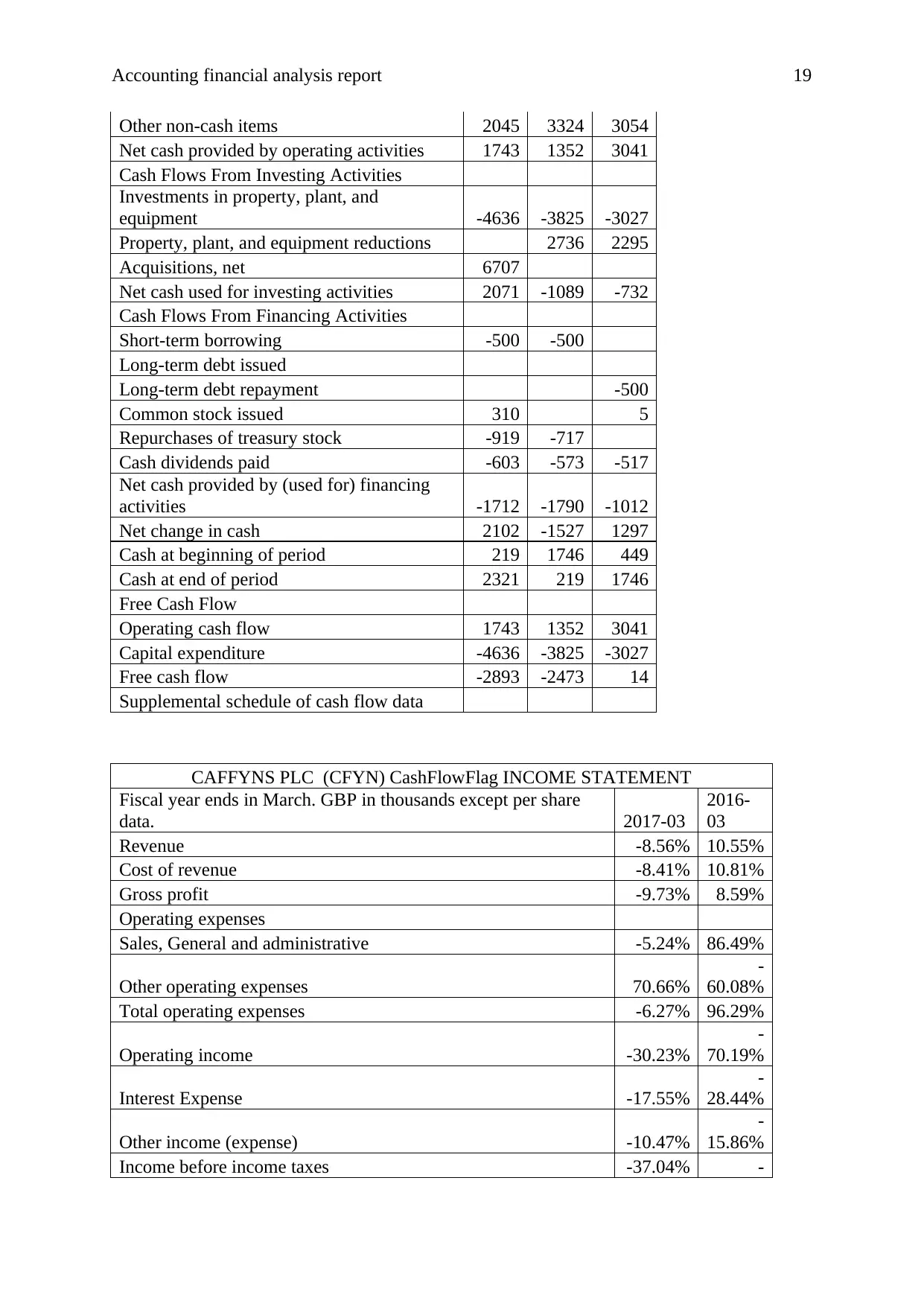
Accounting financial analysis report 19
Other non-cash items 2045 3324 3054
Net cash provided by operating activities 1743 1352 3041
Cash Flows From Investing Activities
Investments in property, plant, and
equipment -4636 -3825 -3027
Property, plant, and equipment reductions 2736 2295
Acquisitions, net 6707
Net cash used for investing activities 2071 -1089 -732
Cash Flows From Financing Activities
Short-term borrowing -500 -500
Long-term debt issued
Long-term debt repayment -500
Common stock issued 310 5
Repurchases of treasury stock -919 -717
Cash dividends paid -603 -573 -517
Net cash provided by (used for) financing
activities -1712 -1790 -1012
Net change in cash 2102 -1527 1297
Cash at beginning of period 219 1746 449
Cash at end of period 2321 219 1746
Free Cash Flow
Operating cash flow 1743 1352 3041
Capital expenditure -4636 -3825 -3027
Free cash flow -2893 -2473 14
Supplemental schedule of cash flow data
CAFFYNS PLC (CFYN) CashFlowFlag INCOME STATEMENT
Fiscal year ends in March. GBP in thousands except per share
data. 2017-03
2016-
03
Revenue -8.56% 10.55%
Cost of revenue -8.41% 10.81%
Gross profit -9.73% 8.59%
Operating expenses
Sales, General and administrative -5.24% 86.49%
Other operating expenses 70.66%
-
60.08%
Total operating expenses -6.27% 96.29%
Operating income -30.23%
-
70.19%
Interest Expense -17.55%
-
28.44%
Other income (expense) -10.47%
-
15.86%
Income before income taxes -37.04% -
Other non-cash items 2045 3324 3054
Net cash provided by operating activities 1743 1352 3041
Cash Flows From Investing Activities
Investments in property, plant, and
equipment -4636 -3825 -3027
Property, plant, and equipment reductions 2736 2295
Acquisitions, net 6707
Net cash used for investing activities 2071 -1089 -732
Cash Flows From Financing Activities
Short-term borrowing -500 -500
Long-term debt issued
Long-term debt repayment -500
Common stock issued 310 5
Repurchases of treasury stock -919 -717
Cash dividends paid -603 -573 -517
Net cash provided by (used for) financing
activities -1712 -1790 -1012
Net change in cash 2102 -1527 1297
Cash at beginning of period 219 1746 449
Cash at end of period 2321 219 1746
Free Cash Flow
Operating cash flow 1743 1352 3041
Capital expenditure -4636 -3825 -3027
Free cash flow -2893 -2473 14
Supplemental schedule of cash flow data
CAFFYNS PLC (CFYN) CashFlowFlag INCOME STATEMENT
Fiscal year ends in March. GBP in thousands except per share
data. 2017-03
2016-
03
Revenue -8.56% 10.55%
Cost of revenue -8.41% 10.81%
Gross profit -9.73% 8.59%
Operating expenses
Sales, General and administrative -5.24% 86.49%
Other operating expenses 70.66%
-
60.08%
Total operating expenses -6.27% 96.29%
Operating income -30.23%
-
70.19%
Interest Expense -17.55%
-
28.44%
Other income (expense) -10.47%
-
15.86%
Income before income taxes -37.04% -
Paraphrase This Document
Need a fresh take? Get an instant paraphrase of this document with our AI Paraphraser
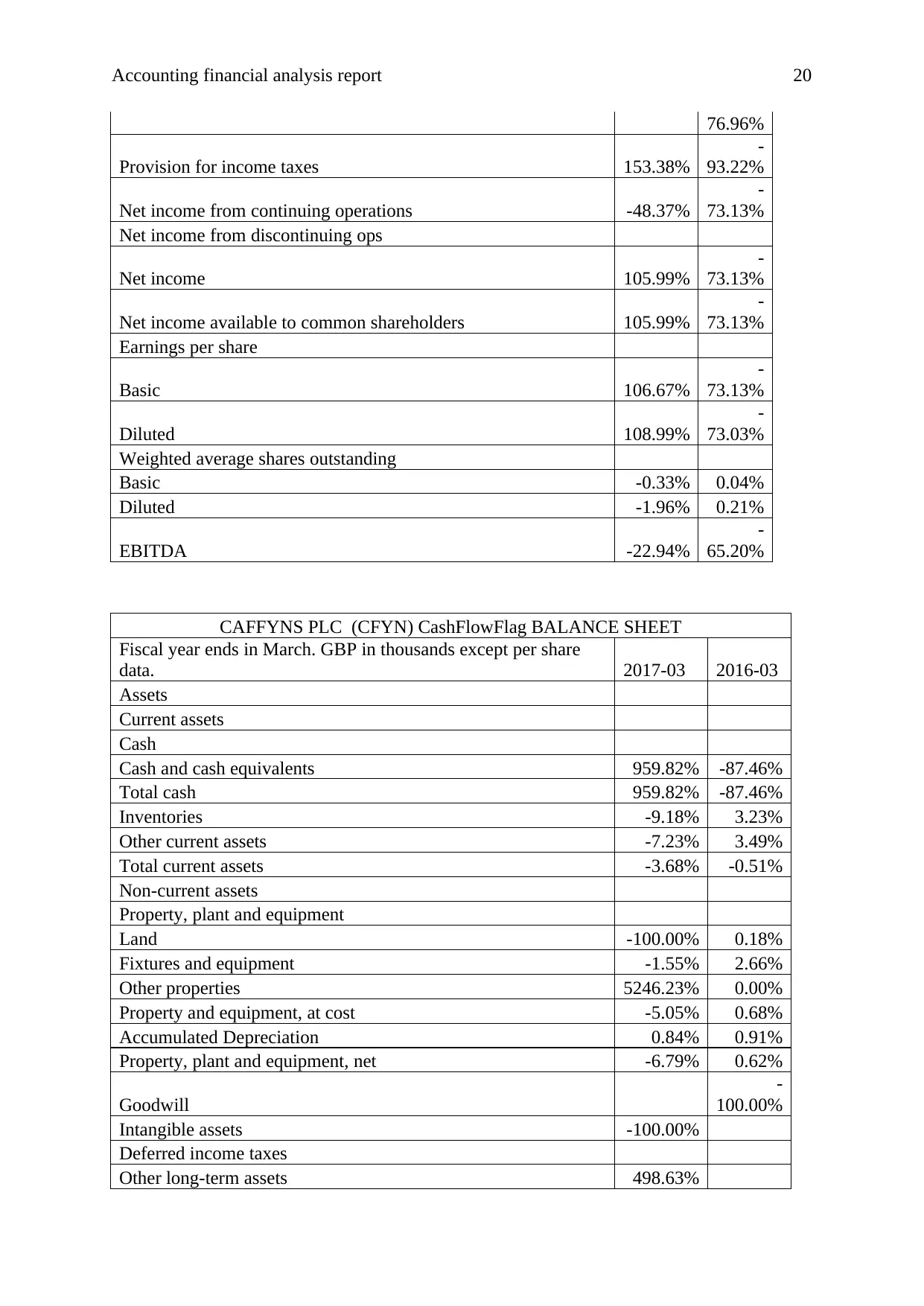
Accounting financial analysis report 20
76.96%
Provision for income taxes 153.38%
-
93.22%
Net income from continuing operations -48.37%
-
73.13%
Net income from discontinuing ops
Net income 105.99%
-
73.13%
Net income available to common shareholders 105.99%
-
73.13%
Earnings per share
Basic 106.67%
-
73.13%
Diluted 108.99%
-
73.03%
Weighted average shares outstanding
Basic -0.33% 0.04%
Diluted -1.96% 0.21%
EBITDA -22.94%
-
65.20%
CAFFYNS PLC (CFYN) CashFlowFlag BALANCE SHEET
Fiscal year ends in March. GBP in thousands except per share
data. 2017-03 2016-03
Assets
Current assets
Cash
Cash and cash equivalents 959.82% -87.46%
Total cash 959.82% -87.46%
Inventories -9.18% 3.23%
Other current assets -7.23% 3.49%
Total current assets -3.68% -0.51%
Non-current assets
Property, plant and equipment
Land -100.00% 0.18%
Fixtures and equipment -1.55% 2.66%
Other properties 5246.23% 0.00%
Property and equipment, at cost -5.05% 0.68%
Accumulated Depreciation 0.84% 0.91%
Property, plant and equipment, net -6.79% 0.62%
Goodwill
-
100.00%
Intangible assets -100.00%
Deferred income taxes
Other long-term assets 498.63%
76.96%
Provision for income taxes 153.38%
-
93.22%
Net income from continuing operations -48.37%
-
73.13%
Net income from discontinuing ops
Net income 105.99%
-
73.13%
Net income available to common shareholders 105.99%
-
73.13%
Earnings per share
Basic 106.67%
-
73.13%
Diluted 108.99%
-
73.03%
Weighted average shares outstanding
Basic -0.33% 0.04%
Diluted -1.96% 0.21%
EBITDA -22.94%
-
65.20%
CAFFYNS PLC (CFYN) CashFlowFlag BALANCE SHEET
Fiscal year ends in March. GBP in thousands except per share
data. 2017-03 2016-03
Assets
Current assets
Cash
Cash and cash equivalents 959.82% -87.46%
Total cash 959.82% -87.46%
Inventories -9.18% 3.23%
Other current assets -7.23% 3.49%
Total current assets -3.68% -0.51%
Non-current assets
Property, plant and equipment
Land -100.00% 0.18%
Fixtures and equipment -1.55% 2.66%
Other properties 5246.23% 0.00%
Property and equipment, at cost -5.05% 0.68%
Accumulated Depreciation 0.84% 0.91%
Property, plant and equipment, net -6.79% 0.62%
Goodwill
-
100.00%
Intangible assets -100.00%
Deferred income taxes
Other long-term assets 498.63%
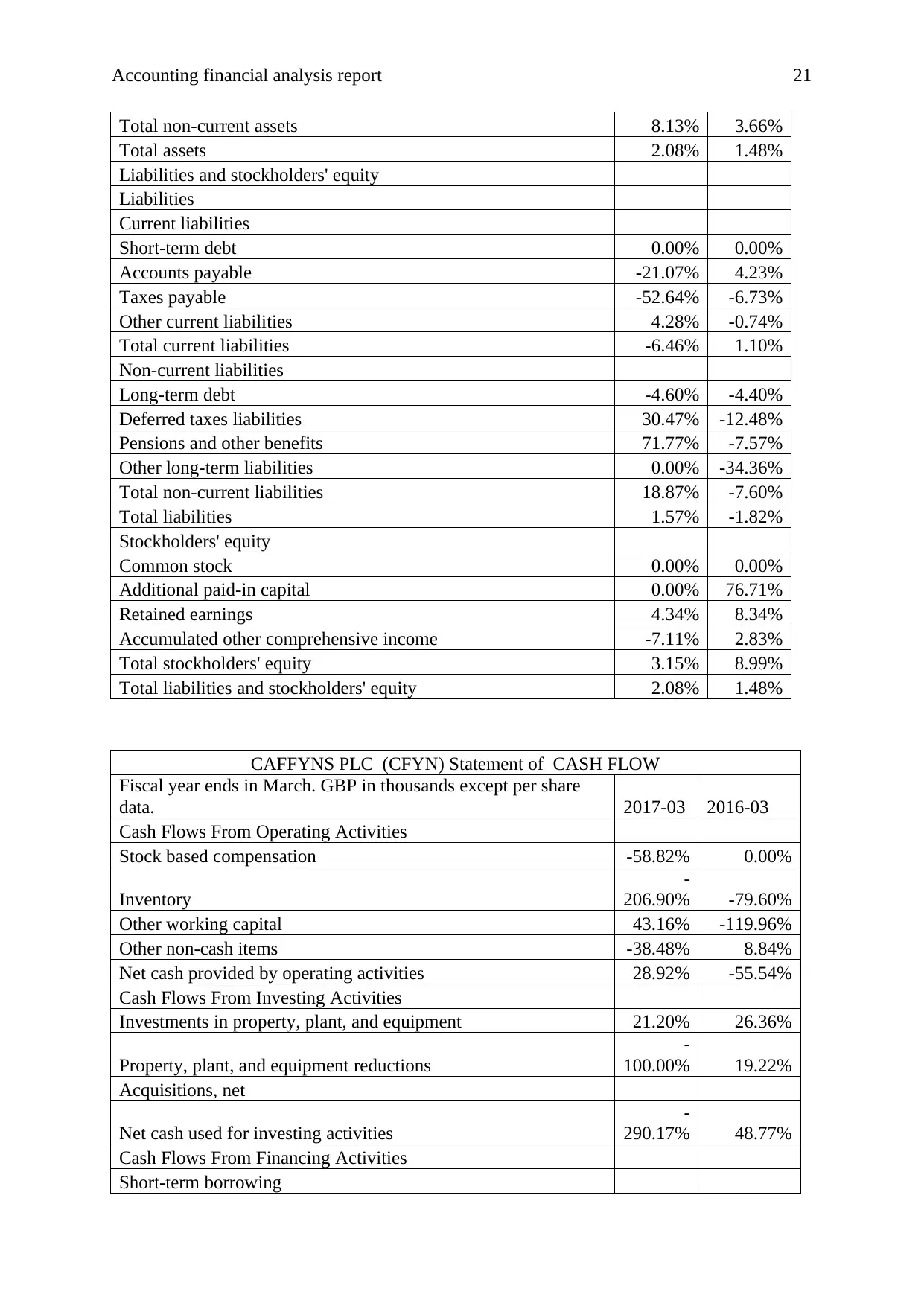
Accounting financial analysis report 21
Total non-current assets 8.13% 3.66%
Total assets 2.08% 1.48%
Liabilities and stockholders' equity
Liabilities
Current liabilities
Short-term debt 0.00% 0.00%
Accounts payable -21.07% 4.23%
Taxes payable -52.64% -6.73%
Other current liabilities 4.28% -0.74%
Total current liabilities -6.46% 1.10%
Non-current liabilities
Long-term debt -4.60% -4.40%
Deferred taxes liabilities 30.47% -12.48%
Pensions and other benefits 71.77% -7.57%
Other long-term liabilities 0.00% -34.36%
Total non-current liabilities 18.87% -7.60%
Total liabilities 1.57% -1.82%
Stockholders' equity
Common stock 0.00% 0.00%
Additional paid-in capital 0.00% 76.71%
Retained earnings 4.34% 8.34%
Accumulated other comprehensive income -7.11% 2.83%
Total stockholders' equity 3.15% 8.99%
Total liabilities and stockholders' equity 2.08% 1.48%
CAFFYNS PLC (CFYN) Statement of CASH FLOW
Fiscal year ends in March. GBP in thousands except per share
data. 2017-03 2016-03
Cash Flows From Operating Activities
Stock based compensation -58.82% 0.00%
Inventory
-
206.90% -79.60%
Other working capital 43.16% -119.96%
Other non-cash items -38.48% 8.84%
Net cash provided by operating activities 28.92% -55.54%
Cash Flows From Investing Activities
Investments in property, plant, and equipment 21.20% 26.36%
Property, plant, and equipment reductions
-
100.00% 19.22%
Acquisitions, net
Net cash used for investing activities
-
290.17% 48.77%
Cash Flows From Financing Activities
Short-term borrowing
Total non-current assets 8.13% 3.66%
Total assets 2.08% 1.48%
Liabilities and stockholders' equity
Liabilities
Current liabilities
Short-term debt 0.00% 0.00%
Accounts payable -21.07% 4.23%
Taxes payable -52.64% -6.73%
Other current liabilities 4.28% -0.74%
Total current liabilities -6.46% 1.10%
Non-current liabilities
Long-term debt -4.60% -4.40%
Deferred taxes liabilities 30.47% -12.48%
Pensions and other benefits 71.77% -7.57%
Other long-term liabilities 0.00% -34.36%
Total non-current liabilities 18.87% -7.60%
Total liabilities 1.57% -1.82%
Stockholders' equity
Common stock 0.00% 0.00%
Additional paid-in capital 0.00% 76.71%
Retained earnings 4.34% 8.34%
Accumulated other comprehensive income -7.11% 2.83%
Total stockholders' equity 3.15% 8.99%
Total liabilities and stockholders' equity 2.08% 1.48%
CAFFYNS PLC (CFYN) Statement of CASH FLOW
Fiscal year ends in March. GBP in thousands except per share
data. 2017-03 2016-03
Cash Flows From Operating Activities
Stock based compensation -58.82% 0.00%
Inventory
-
206.90% -79.60%
Other working capital 43.16% -119.96%
Other non-cash items -38.48% 8.84%
Net cash provided by operating activities 28.92% -55.54%
Cash Flows From Investing Activities
Investments in property, plant, and equipment 21.20% 26.36%
Property, plant, and equipment reductions
-
100.00% 19.22%
Acquisitions, net
Net cash used for investing activities
-
290.17% 48.77%
Cash Flows From Financing Activities
Short-term borrowing
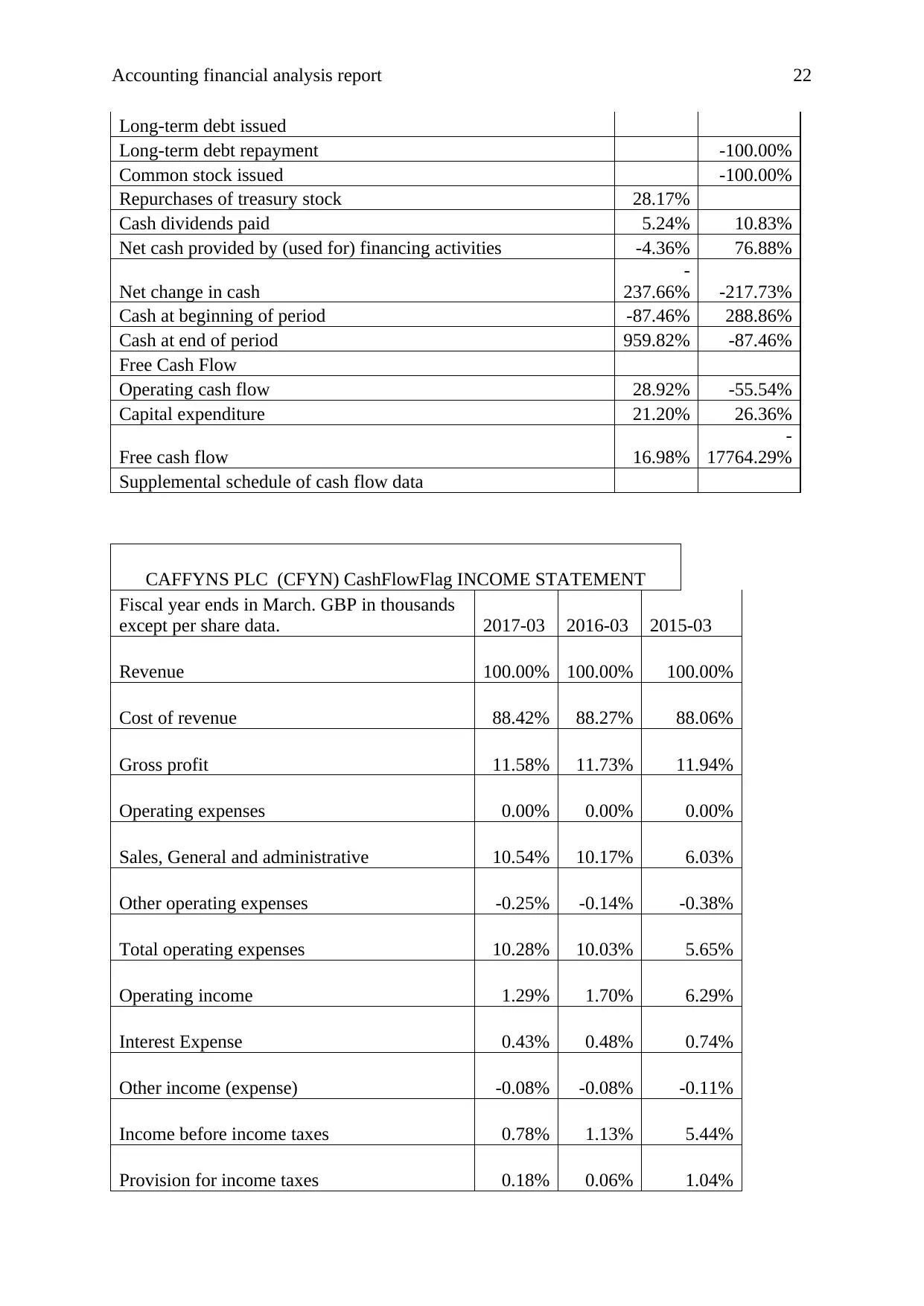
Accounting financial analysis report 22
Long-term debt issued
Long-term debt repayment -100.00%
Common stock issued -100.00%
Repurchases of treasury stock 28.17%
Cash dividends paid 5.24% 10.83%
Net cash provided by (used for) financing activities -4.36% 76.88%
Net change in cash
-
237.66% -217.73%
Cash at beginning of period -87.46% 288.86%
Cash at end of period 959.82% -87.46%
Free Cash Flow
Operating cash flow 28.92% -55.54%
Capital expenditure 21.20% 26.36%
Free cash flow 16.98%
-
17764.29%
Supplemental schedule of cash flow data
CAFFYNS PLC (CFYN) CashFlowFlag INCOME STATEMENT
Fiscal year ends in March. GBP in thousands
except per share data. 2017-03 2016-03 2015-03
Revenue 100.00% 100.00% 100.00%
Cost of revenue 88.42% 88.27% 88.06%
Gross profit 11.58% 11.73% 11.94%
Operating expenses 0.00% 0.00% 0.00%
Sales, General and administrative 10.54% 10.17% 6.03%
Other operating expenses -0.25% -0.14% -0.38%
Total operating expenses 10.28% 10.03% 5.65%
Operating income 1.29% 1.70% 6.29%
Interest Expense 0.43% 0.48% 0.74%
Other income (expense) -0.08% -0.08% -0.11%
Income before income taxes 0.78% 1.13% 5.44%
Provision for income taxes 0.18% 0.06% 1.04%
Long-term debt issued
Long-term debt repayment -100.00%
Common stock issued -100.00%
Repurchases of treasury stock 28.17%
Cash dividends paid 5.24% 10.83%
Net cash provided by (used for) financing activities -4.36% 76.88%
Net change in cash
-
237.66% -217.73%
Cash at beginning of period -87.46% 288.86%
Cash at end of period 959.82% -87.46%
Free Cash Flow
Operating cash flow 28.92% -55.54%
Capital expenditure 21.20% 26.36%
Free cash flow 16.98%
-
17764.29%
Supplemental schedule of cash flow data
CAFFYNS PLC (CFYN) CashFlowFlag INCOME STATEMENT
Fiscal year ends in March. GBP in thousands
except per share data. 2017-03 2016-03 2015-03
Revenue 100.00% 100.00% 100.00%
Cost of revenue 88.42% 88.27% 88.06%
Gross profit 11.58% 11.73% 11.94%
Operating expenses 0.00% 0.00% 0.00%
Sales, General and administrative 10.54% 10.17% 6.03%
Other operating expenses -0.25% -0.14% -0.38%
Total operating expenses 10.28% 10.03% 5.65%
Operating income 1.29% 1.70% 6.29%
Interest Expense 0.43% 0.48% 0.74%
Other income (expense) -0.08% -0.08% -0.11%
Income before income taxes 0.78% 1.13% 5.44%
Provision for income taxes 0.18% 0.06% 1.04%
Secure Best Marks with AI Grader
Need help grading? Try our AI Grader for instant feedback on your assignments.
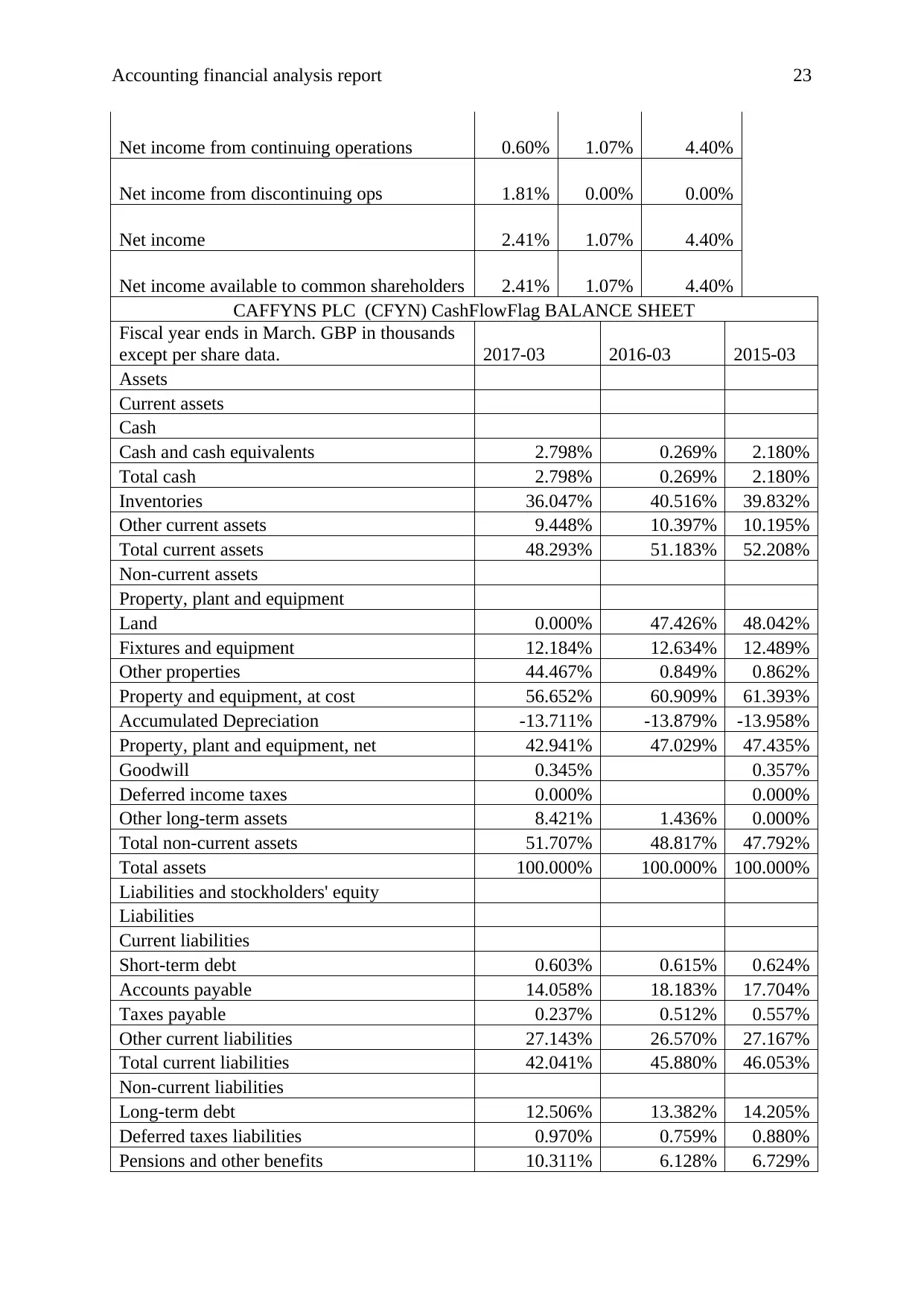
Accounting financial analysis report 23
Net income from continuing operations 0.60% 1.07% 4.40%
Net income from discontinuing ops 1.81% 0.00% 0.00%
Net income 2.41% 1.07% 4.40%
Net income available to common shareholders 2.41% 1.07% 4.40%
CAFFYNS PLC (CFYN) CashFlowFlag BALANCE SHEET
Fiscal year ends in March. GBP in thousands
except per share data. 2017-03 2016-03 2015-03
Assets
Current assets
Cash
Cash and cash equivalents 2.798% 0.269% 2.180%
Total cash 2.798% 0.269% 2.180%
Inventories 36.047% 40.516% 39.832%
Other current assets 9.448% 10.397% 10.195%
Total current assets 48.293% 51.183% 52.208%
Non-current assets
Property, plant and equipment
Land 0.000% 47.426% 48.042%
Fixtures and equipment 12.184% 12.634% 12.489%
Other properties 44.467% 0.849% 0.862%
Property and equipment, at cost 56.652% 60.909% 61.393%
Accumulated Depreciation -13.711% -13.879% -13.958%
Property, plant and equipment, net 42.941% 47.029% 47.435%
Goodwill 0.345% 0.357%
Deferred income taxes 0.000% 0.000%
Other long-term assets 8.421% 1.436% 0.000%
Total non-current assets 51.707% 48.817% 47.792%
Total assets 100.000% 100.000% 100.000%
Liabilities and stockholders' equity
Liabilities
Current liabilities
Short-term debt 0.603% 0.615% 0.624%
Accounts payable 14.058% 18.183% 17.704%
Taxes payable 0.237% 0.512% 0.557%
Other current liabilities 27.143% 26.570% 27.167%
Total current liabilities 42.041% 45.880% 46.053%
Non-current liabilities
Long-term debt 12.506% 13.382% 14.205%
Deferred taxes liabilities 0.970% 0.759% 0.880%
Pensions and other benefits 10.311% 6.128% 6.729%
Net income from continuing operations 0.60% 1.07% 4.40%
Net income from discontinuing ops 1.81% 0.00% 0.00%
Net income 2.41% 1.07% 4.40%
Net income available to common shareholders 2.41% 1.07% 4.40%
CAFFYNS PLC (CFYN) CashFlowFlag BALANCE SHEET
Fiscal year ends in March. GBP in thousands
except per share data. 2017-03 2016-03 2015-03
Assets
Current assets
Cash
Cash and cash equivalents 2.798% 0.269% 2.180%
Total cash 2.798% 0.269% 2.180%
Inventories 36.047% 40.516% 39.832%
Other current assets 9.448% 10.397% 10.195%
Total current assets 48.293% 51.183% 52.208%
Non-current assets
Property, plant and equipment
Land 0.000% 47.426% 48.042%
Fixtures and equipment 12.184% 12.634% 12.489%
Other properties 44.467% 0.849% 0.862%
Property and equipment, at cost 56.652% 60.909% 61.393%
Accumulated Depreciation -13.711% -13.879% -13.958%
Property, plant and equipment, net 42.941% 47.029% 47.435%
Goodwill 0.345% 0.357%
Deferred income taxes 0.000% 0.000%
Other long-term assets 8.421% 1.436% 0.000%
Total non-current assets 51.707% 48.817% 47.792%
Total assets 100.000% 100.000% 100.000%
Liabilities and stockholders' equity
Liabilities
Current liabilities
Short-term debt 0.603% 0.615% 0.624%
Accounts payable 14.058% 18.183% 17.704%
Taxes payable 0.237% 0.512% 0.557%
Other current liabilities 27.143% 26.570% 27.167%
Total current liabilities 42.041% 45.880% 46.053%
Non-current liabilities
Long-term debt 12.506% 13.382% 14.205%
Deferred taxes liabilities 0.970% 0.759% 0.880%
Pensions and other benefits 10.311% 6.128% 6.729%
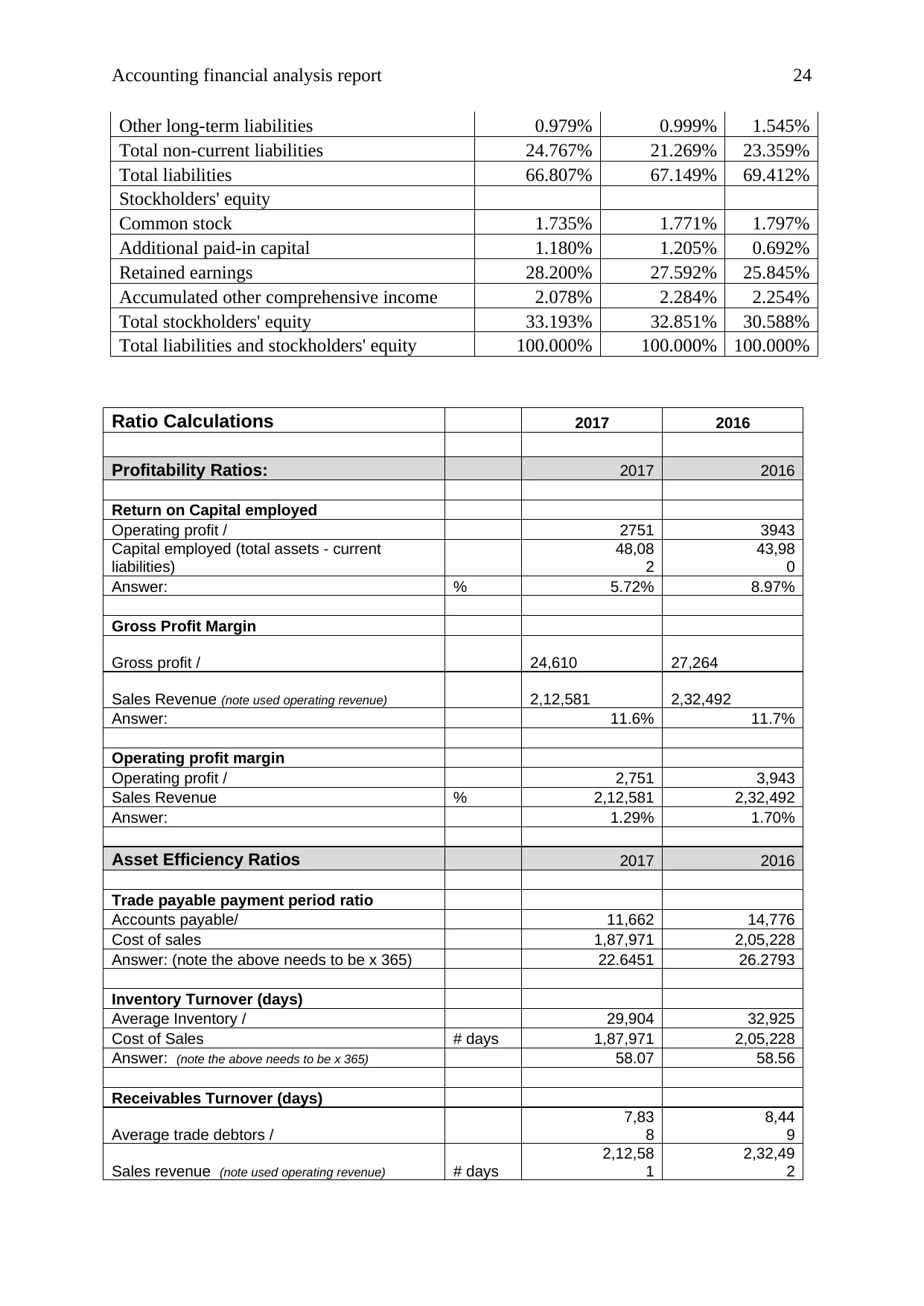
Accounting financial analysis report 24
Other long-term liabilities 0.979% 0.999% 1.545%
Total non-current liabilities 24.767% 21.269% 23.359%
Total liabilities 66.807% 67.149% 69.412%
Stockholders' equity
Common stock 1.735% 1.771% 1.797%
Additional paid-in capital 1.180% 1.205% 0.692%
Retained earnings 28.200% 27.592% 25.845%
Accumulated other comprehensive income 2.078% 2.284% 2.254%
Total stockholders' equity 33.193% 32.851% 30.588%
Total liabilities and stockholders' equity 100.000% 100.000% 100.000%
Ratio Calculations 2017 2016
Profitability Ratios: 2017 2016
Return on Capital employed
Operating profit / 2751 3943
Capital employed (total assets - current
liabilities)
48,08
2
43,98
0
Answer: % 5.72% 8.97%
Gross Profit Margin
Gross profit / 24,610 27,264
Sales Revenue (note used operating revenue) 2,12,581 2,32,492
Answer: 11.6% 11.7%
Operating profit margin
Operating profit / 2,751 3,943
Sales Revenue % 2,12,581 2,32,492
Answer: 1.29% 1.70%
Asset Efficiency Ratios 2017 2016
Trade payable payment period ratio
Accounts payable/ 11,662 14,776
Cost of sales 1,87,971 2,05,228
Answer: (note the above needs to be x 365) 22.6451 26.2793
Inventory Turnover (days)
Average Inventory / 29,904 32,925
Cost of Sales # days 1,87,971 2,05,228
Answer: (note the above needs to be x 365) 58.07 58.56
Receivables Turnover (days)
Average trade debtors /
7,83
8
8,44
9
Sales revenue (note used operating revenue) # days
2,12,58
1
2,32,49
2
Other long-term liabilities 0.979% 0.999% 1.545%
Total non-current liabilities 24.767% 21.269% 23.359%
Total liabilities 66.807% 67.149% 69.412%
Stockholders' equity
Common stock 1.735% 1.771% 1.797%
Additional paid-in capital 1.180% 1.205% 0.692%
Retained earnings 28.200% 27.592% 25.845%
Accumulated other comprehensive income 2.078% 2.284% 2.254%
Total stockholders' equity 33.193% 32.851% 30.588%
Total liabilities and stockholders' equity 100.000% 100.000% 100.000%
Ratio Calculations 2017 2016
Profitability Ratios: 2017 2016
Return on Capital employed
Operating profit / 2751 3943
Capital employed (total assets - current
liabilities)
48,08
2
43,98
0
Answer: % 5.72% 8.97%
Gross Profit Margin
Gross profit / 24,610 27,264
Sales Revenue (note used operating revenue) 2,12,581 2,32,492
Answer: 11.6% 11.7%
Operating profit margin
Operating profit / 2,751 3,943
Sales Revenue % 2,12,581 2,32,492
Answer: 1.29% 1.70%
Asset Efficiency Ratios 2017 2016
Trade payable payment period ratio
Accounts payable/ 11,662 14,776
Cost of sales 1,87,971 2,05,228
Answer: (note the above needs to be x 365) 22.6451 26.2793
Inventory Turnover (days)
Average Inventory / 29,904 32,925
Cost of Sales # days 1,87,971 2,05,228
Answer: (note the above needs to be x 365) 58.07 58.56
Receivables Turnover (days)
Average trade debtors /
7,83
8
8,44
9
Sales revenue (note used operating revenue) # days
2,12,58
1
2,32,49
2
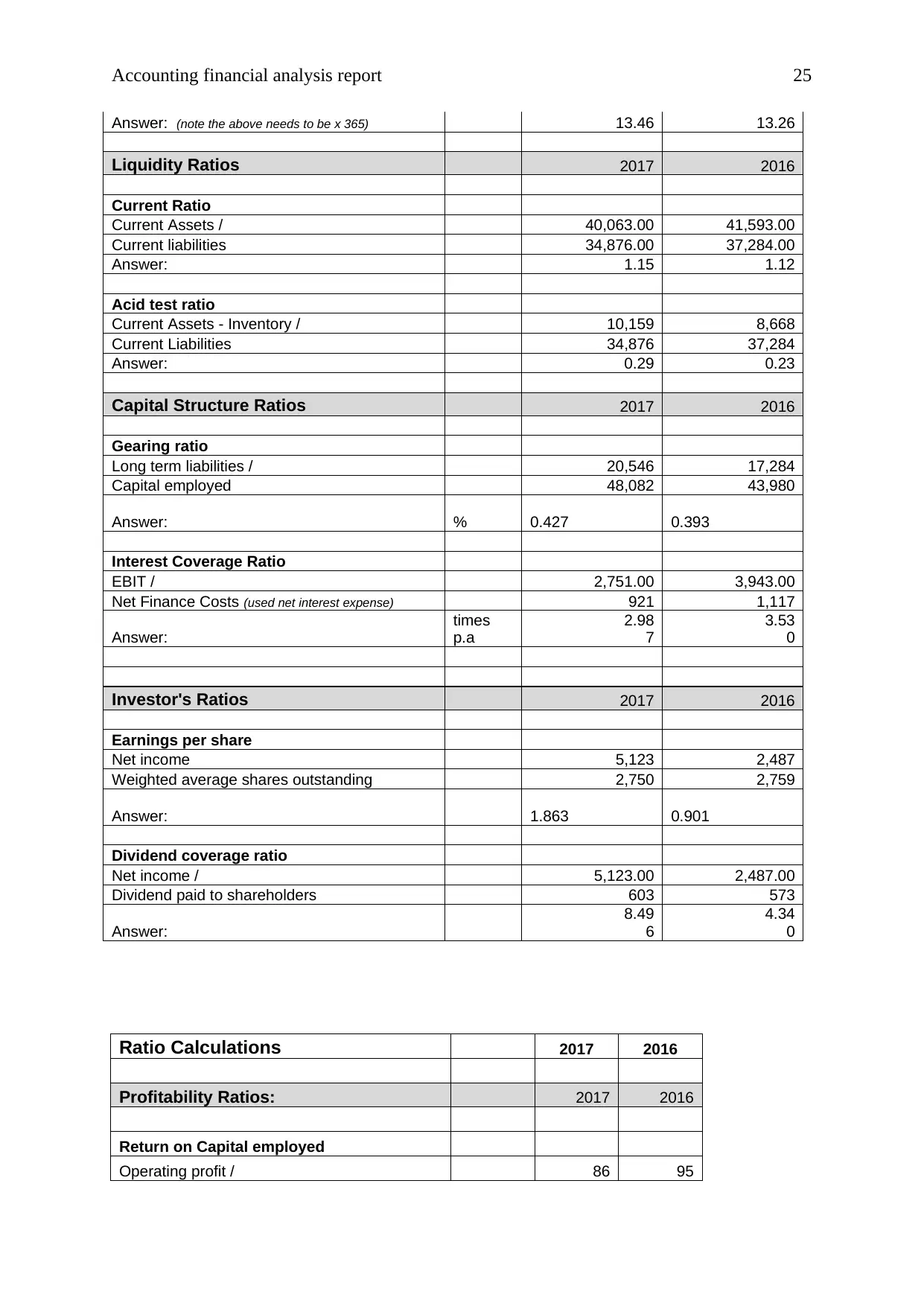
Accounting financial analysis report 25
Answer: (note the above needs to be x 365) 13.46 13.26
Liquidity Ratios 2017 2016
Current Ratio
Current Assets / 40,063.00 41,593.00
Current liabilities 34,876.00 37,284.00
Answer: 1.15 1.12
Acid test ratio
Current Assets - Inventory / 10,159 8,668
Current Liabilities 34,876 37,284
Answer: 0.29 0.23
Capital Structure Ratios 2017 2016
Gearing ratio
Long term liabilities / 20,546 17,284
Capital employed 48,082 43,980
Answer: % 0.427 0.393
Interest Coverage Ratio
EBIT / 2,751.00 3,943.00
Net Finance Costs (used net interest expense) 921 1,117
Answer:
times
p.a
2.98
7
3.53
0
Investor's Ratios 2017 2016
Earnings per share
Net income 5,123 2,487
Weighted average shares outstanding 2,750 2,759
Answer: 1.863 0.901
Dividend coverage ratio
Net income / 5,123.00 2,487.00
Dividend paid to shareholders 603 573
Answer:
8.49
6
4.34
0
Ratio Calculations 2017 2016
Profitability Ratios: 2017 2016
Return on Capital employed
Operating profit / 86 95
Answer: (note the above needs to be x 365) 13.46 13.26
Liquidity Ratios 2017 2016
Current Ratio
Current Assets / 40,063.00 41,593.00
Current liabilities 34,876.00 37,284.00
Answer: 1.15 1.12
Acid test ratio
Current Assets - Inventory / 10,159 8,668
Current Liabilities 34,876 37,284
Answer: 0.29 0.23
Capital Structure Ratios 2017 2016
Gearing ratio
Long term liabilities / 20,546 17,284
Capital employed 48,082 43,980
Answer: % 0.427 0.393
Interest Coverage Ratio
EBIT / 2,751.00 3,943.00
Net Finance Costs (used net interest expense) 921 1,117
Answer:
times
p.a
2.98
7
3.53
0
Investor's Ratios 2017 2016
Earnings per share
Net income 5,123 2,487
Weighted average shares outstanding 2,750 2,759
Answer: 1.863 0.901
Dividend coverage ratio
Net income / 5,123.00 2,487.00
Dividend paid to shareholders 603 573
Answer:
8.49
6
4.34
0
Ratio Calculations 2017 2016
Profitability Ratios: 2017 2016
Return on Capital employed
Operating profit / 86 95
Paraphrase This Document
Need a fresh take? Get an instant paraphrase of this document with our AI Paraphraser

Accounting financial analysis report 26
Capital employed (total assets - current
liabilities)
78
4
75
7
Answer: % 10.97% 12.55%
Gross Profit Margin
Gross profit / 553 560
Sales Revenue (note used operating revenue) 4,739 4,537
Answer: 11.7% 12.3%
Operating profit margin
Operating profit / 86 95
Sales Revenue % 4,739 4,537
Answer: 1.81% 2.09%
Asset Efficiency Ratios 2017 2016
Trade payable payment period ratio
Accounts payable/ 1,224 1,069
Cost of sales 4,186 3,977
Answer: (note the above needs to be x 365) 106.7272 98.1104
Inventory Turnover (days)
Average Inventory / 1,004 846
Cost of Sales # days 4,186 3,977
Answer: (note the above needs to be x 365) 87.54 77.64
Receivables Turnover (days)
Average trade debtors /
12
8
14
4
Sales revenue (note used operating revenue) # days
4,73
9
4,53
7
Answer: (note the above needs to be x 365) 9.86 11.58
Liquidity Ratios 2017 2016
Current Ratio
Current Assets / 1,201.00 1,090.00
Current liabilities 1,277.00 1,119.00
Answer: 0.94 0.97
Acid test ratio
Current Assets - Inventory / 197 244
Current Liabilities 1,277 1,119
Answer: 0.15 0.22
Capital employed (total assets - current
liabilities)
78
4
75
7
Answer: % 10.97% 12.55%
Gross Profit Margin
Gross profit / 553 560
Sales Revenue (note used operating revenue) 4,739 4,537
Answer: 11.7% 12.3%
Operating profit margin
Operating profit / 86 95
Sales Revenue % 4,739 4,537
Answer: 1.81% 2.09%
Asset Efficiency Ratios 2017 2016
Trade payable payment period ratio
Accounts payable/ 1,224 1,069
Cost of sales 4,186 3,977
Answer: (note the above needs to be x 365) 106.7272 98.1104
Inventory Turnover (days)
Average Inventory / 1,004 846
Cost of Sales # days 4,186 3,977
Answer: (note the above needs to be x 365) 87.54 77.64
Receivables Turnover (days)
Average trade debtors /
12
8
14
4
Sales revenue (note used operating revenue) # days
4,73
9
4,53
7
Answer: (note the above needs to be x 365) 9.86 11.58
Liquidity Ratios 2017 2016
Current Ratio
Current Assets / 1,201.00 1,090.00
Current liabilities 1,277.00 1,119.00
Answer: 0.94 0.97
Acid test ratio
Current Assets - Inventory / 197 244
Current Liabilities 1,277 1,119
Answer: 0.15 0.22
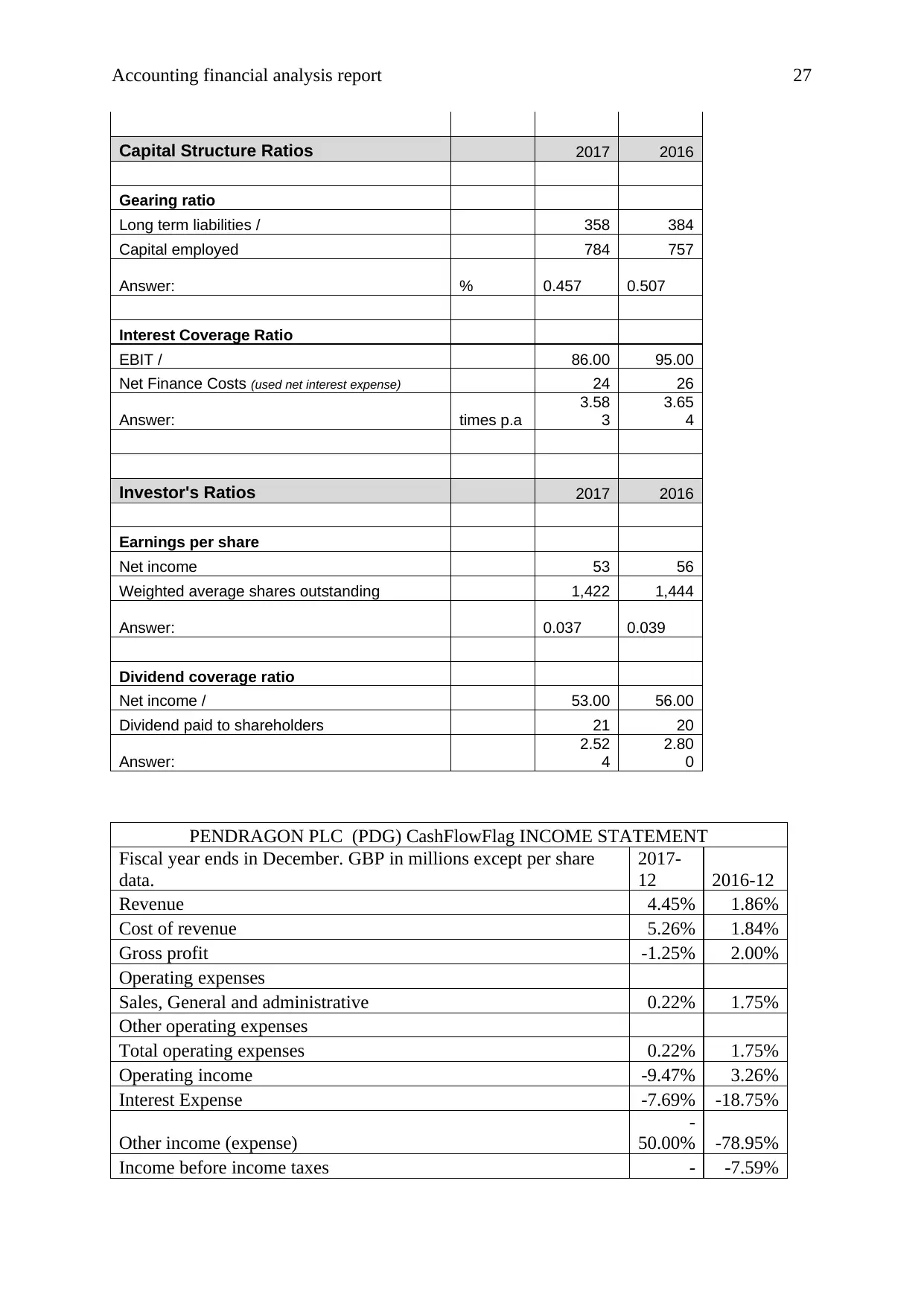
Accounting financial analysis report 27
Capital Structure Ratios 2017 2016
Gearing ratio
Long term liabilities / 358 384
Capital employed 784 757
Answer: % 0.457 0.507
Interest Coverage Ratio
EBIT / 86.00 95.00
Net Finance Costs (used net interest expense) 24 26
Answer: times p.a
3.58
3
3.65
4
Investor's Ratios 2017 2016
Earnings per share
Net income 53 56
Weighted average shares outstanding 1,422 1,444
Answer: 0.037 0.039
Dividend coverage ratio
Net income / 53.00 56.00
Dividend paid to shareholders 21 20
Answer:
2.52
4
2.80
0
PENDRAGON PLC (PDG) CashFlowFlag INCOME STATEMENT
Fiscal year ends in December. GBP in millions except per share
data.
2017-
12 2016-12
Revenue 4.45% 1.86%
Cost of revenue 5.26% 1.84%
Gross profit -1.25% 2.00%
Operating expenses
Sales, General and administrative 0.22% 1.75%
Other operating expenses
Total operating expenses 0.22% 1.75%
Operating income -9.47% 3.26%
Interest Expense -7.69% -18.75%
Other income (expense)
-
50.00% -78.95%
Income before income taxes - -7.59%
Capital Structure Ratios 2017 2016
Gearing ratio
Long term liabilities / 358 384
Capital employed 784 757
Answer: % 0.457 0.507
Interest Coverage Ratio
EBIT / 86.00 95.00
Net Finance Costs (used net interest expense) 24 26
Answer: times p.a
3.58
3
3.65
4
Investor's Ratios 2017 2016
Earnings per share
Net income 53 56
Weighted average shares outstanding 1,422 1,444
Answer: 0.037 0.039
Dividend coverage ratio
Net income / 53.00 56.00
Dividend paid to shareholders 21 20
Answer:
2.52
4
2.80
0
PENDRAGON PLC (PDG) CashFlowFlag INCOME STATEMENT
Fiscal year ends in December. GBP in millions except per share
data.
2017-
12 2016-12
Revenue 4.45% 1.86%
Cost of revenue 5.26% 1.84%
Gross profit -1.25% 2.00%
Operating expenses
Sales, General and administrative 0.22% 1.75%
Other operating expenses
Total operating expenses 0.22% 1.75%
Operating income -9.47% 3.26%
Interest Expense -7.69% -18.75%
Other income (expense)
-
50.00% -78.95%
Income before income taxes - -7.59%
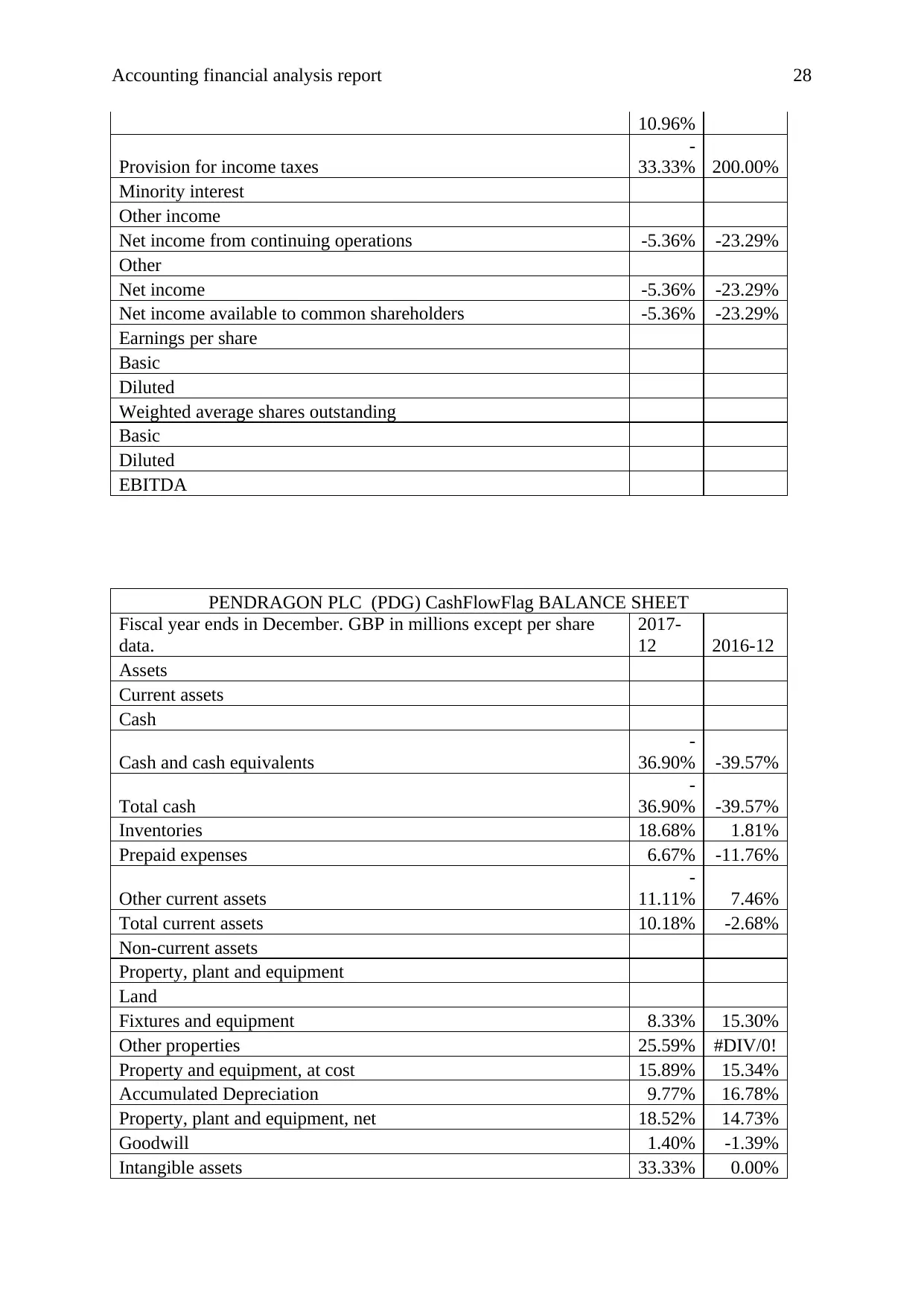
Accounting financial analysis report 28
10.96%
Provision for income taxes
-
33.33% 200.00%
Minority interest
Other income
Net income from continuing operations -5.36% -23.29%
Other
Net income -5.36% -23.29%
Net income available to common shareholders -5.36% -23.29%
Earnings per share
Basic
Diluted
Weighted average shares outstanding
Basic
Diluted
EBITDA
PENDRAGON PLC (PDG) CashFlowFlag BALANCE SHEET
Fiscal year ends in December. GBP in millions except per share
data.
2017-
12 2016-12
Assets
Current assets
Cash
Cash and cash equivalents
-
36.90% -39.57%
Total cash
-
36.90% -39.57%
Inventories 18.68% 1.81%
Prepaid expenses 6.67% -11.76%
Other current assets
-
11.11% 7.46%
Total current assets 10.18% -2.68%
Non-current assets
Property, plant and equipment
Land
Fixtures and equipment 8.33% 15.30%
Other properties 25.59% #DIV/0!
Property and equipment, at cost 15.89% 15.34%
Accumulated Depreciation 9.77% 16.78%
Property, plant and equipment, net 18.52% 14.73%
Goodwill 1.40% -1.39%
Intangible assets 33.33% 0.00%
10.96%
Provision for income taxes
-
33.33% 200.00%
Minority interest
Other income
Net income from continuing operations -5.36% -23.29%
Other
Net income -5.36% -23.29%
Net income available to common shareholders -5.36% -23.29%
Earnings per share
Basic
Diluted
Weighted average shares outstanding
Basic
Diluted
EBITDA
PENDRAGON PLC (PDG) CashFlowFlag BALANCE SHEET
Fiscal year ends in December. GBP in millions except per share
data.
2017-
12 2016-12
Assets
Current assets
Cash
Cash and cash equivalents
-
36.90% -39.57%
Total cash
-
36.90% -39.57%
Inventories 18.68% 1.81%
Prepaid expenses 6.67% -11.76%
Other current assets
-
11.11% 7.46%
Total current assets 10.18% -2.68%
Non-current assets
Property, plant and equipment
Land
Fixtures and equipment 8.33% 15.30%
Other properties 25.59% #DIV/0!
Property and equipment, at cost 15.89% 15.34%
Accumulated Depreciation 9.77% 16.78%
Property, plant and equipment, net 18.52% 14.73%
Goodwill 1.40% -1.39%
Intangible assets 33.33% 0.00%
Secure Best Marks with AI Grader
Need help grading? Try our AI Grader for instant feedback on your assignments.
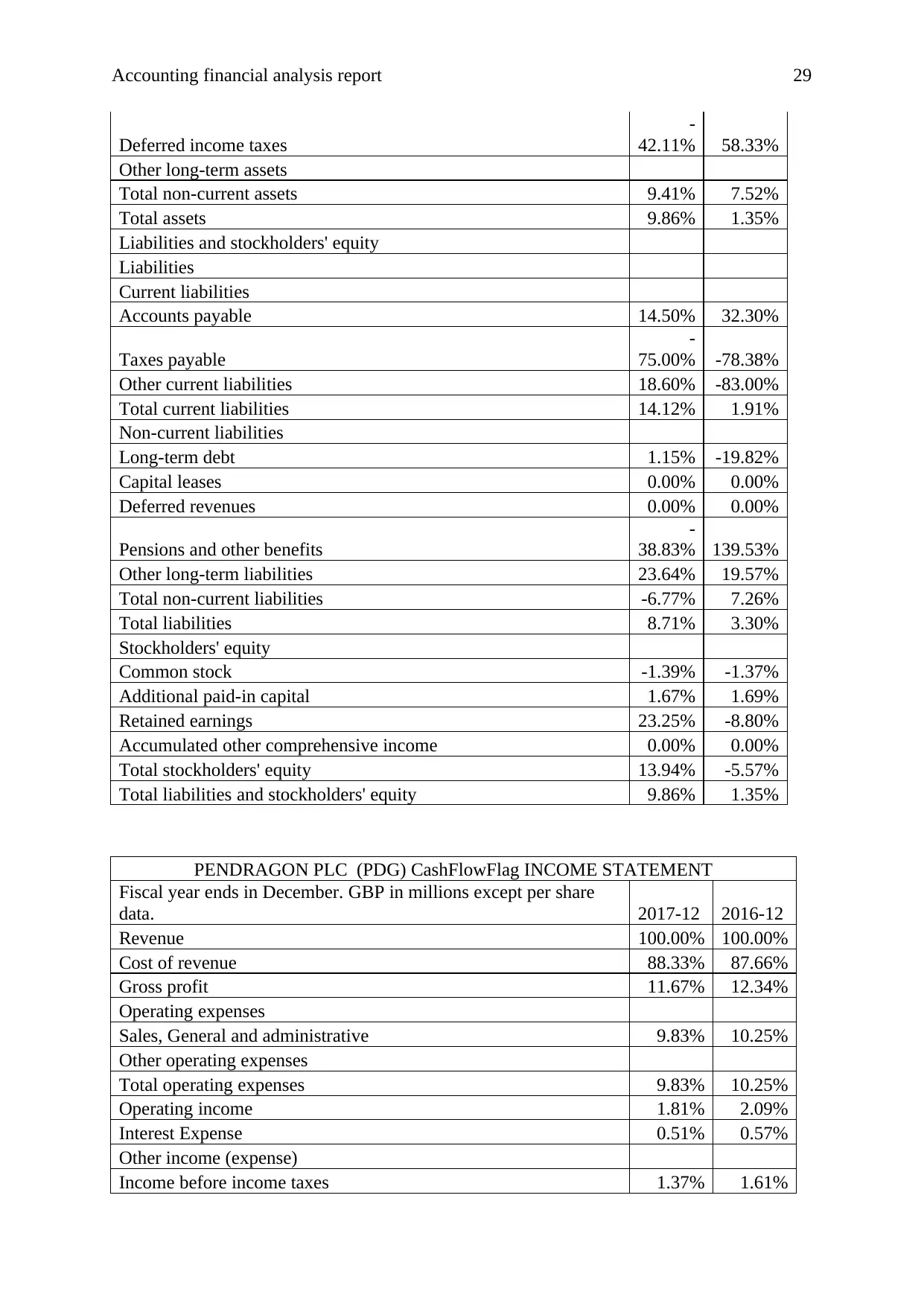
Accounting financial analysis report 29
Deferred income taxes
-
42.11% 58.33%
Other long-term assets
Total non-current assets 9.41% 7.52%
Total assets 9.86% 1.35%
Liabilities and stockholders' equity
Liabilities
Current liabilities
Accounts payable 14.50% 32.30%
Taxes payable
-
75.00% -78.38%
Other current liabilities 18.60% -83.00%
Total current liabilities 14.12% 1.91%
Non-current liabilities
Long-term debt 1.15% -19.82%
Capital leases 0.00% 0.00%
Deferred revenues 0.00% 0.00%
Pensions and other benefits
-
38.83% 139.53%
Other long-term liabilities 23.64% 19.57%
Total non-current liabilities -6.77% 7.26%
Total liabilities 8.71% 3.30%
Stockholders' equity
Common stock -1.39% -1.37%
Additional paid-in capital 1.67% 1.69%
Retained earnings 23.25% -8.80%
Accumulated other comprehensive income 0.00% 0.00%
Total stockholders' equity 13.94% -5.57%
Total liabilities and stockholders' equity 9.86% 1.35%
PENDRAGON PLC (PDG) CashFlowFlag INCOME STATEMENT
Fiscal year ends in December. GBP in millions except per share
data. 2017-12 2016-12
Revenue 100.00% 100.00%
Cost of revenue 88.33% 87.66%
Gross profit 11.67% 12.34%
Operating expenses
Sales, General and administrative 9.83% 10.25%
Other operating expenses
Total operating expenses 9.83% 10.25%
Operating income 1.81% 2.09%
Interest Expense 0.51% 0.57%
Other income (expense)
Income before income taxes 1.37% 1.61%
Deferred income taxes
-
42.11% 58.33%
Other long-term assets
Total non-current assets 9.41% 7.52%
Total assets 9.86% 1.35%
Liabilities and stockholders' equity
Liabilities
Current liabilities
Accounts payable 14.50% 32.30%
Taxes payable
-
75.00% -78.38%
Other current liabilities 18.60% -83.00%
Total current liabilities 14.12% 1.91%
Non-current liabilities
Long-term debt 1.15% -19.82%
Capital leases 0.00% 0.00%
Deferred revenues 0.00% 0.00%
Pensions and other benefits
-
38.83% 139.53%
Other long-term liabilities 23.64% 19.57%
Total non-current liabilities -6.77% 7.26%
Total liabilities 8.71% 3.30%
Stockholders' equity
Common stock -1.39% -1.37%
Additional paid-in capital 1.67% 1.69%
Retained earnings 23.25% -8.80%
Accumulated other comprehensive income 0.00% 0.00%
Total stockholders' equity 13.94% -5.57%
Total liabilities and stockholders' equity 9.86% 1.35%
PENDRAGON PLC (PDG) CashFlowFlag INCOME STATEMENT
Fiscal year ends in December. GBP in millions except per share
data. 2017-12 2016-12
Revenue 100.00% 100.00%
Cost of revenue 88.33% 87.66%
Gross profit 11.67% 12.34%
Operating expenses
Sales, General and administrative 9.83% 10.25%
Other operating expenses
Total operating expenses 9.83% 10.25%
Operating income 1.81% 2.09%
Interest Expense 0.51% 0.57%
Other income (expense)
Income before income taxes 1.37% 1.61%
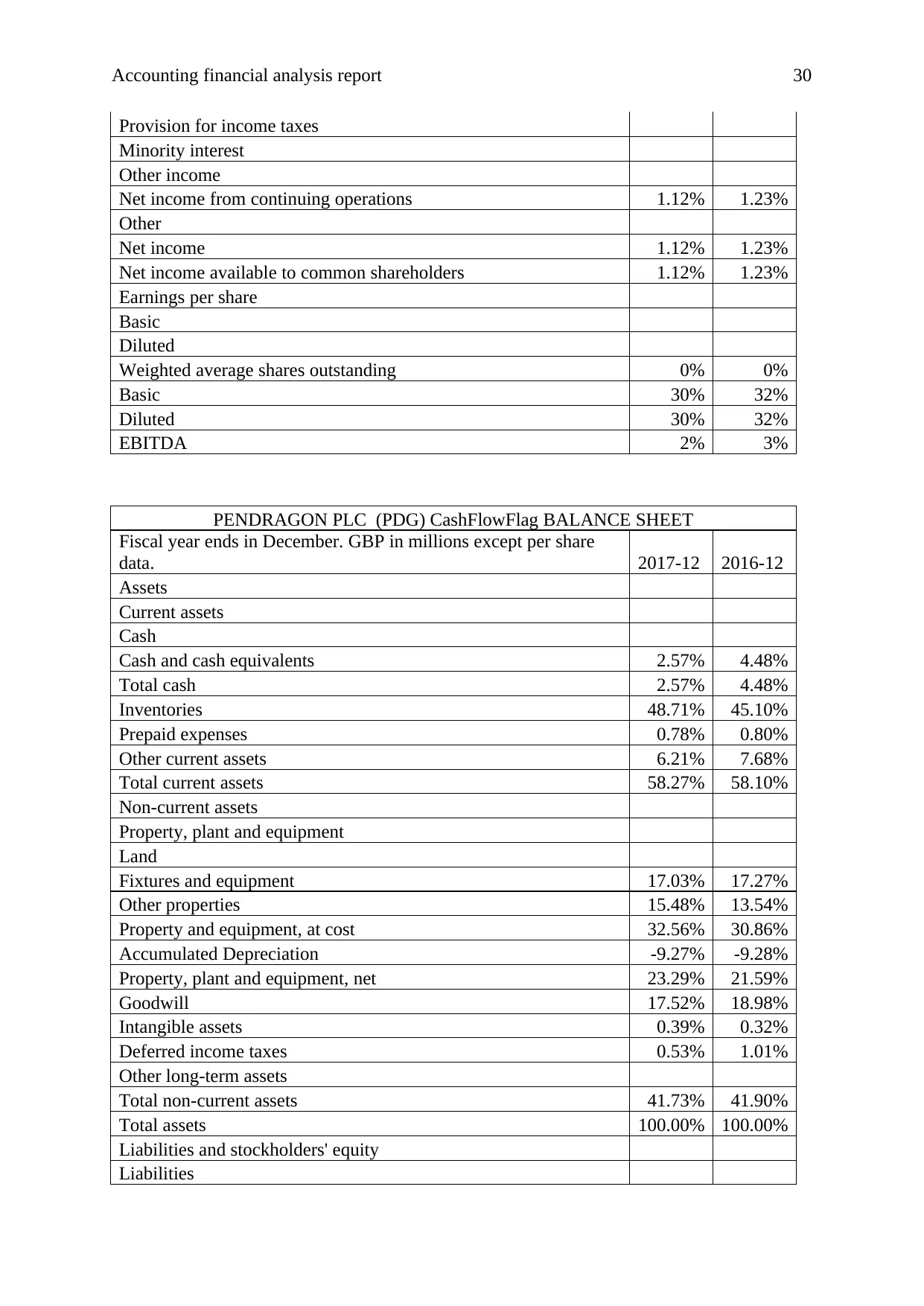
Accounting financial analysis report 30
Provision for income taxes
Minority interest
Other income
Net income from continuing operations 1.12% 1.23%
Other
Net income 1.12% 1.23%
Net income available to common shareholders 1.12% 1.23%
Earnings per share
Basic
Diluted
Weighted average shares outstanding 0% 0%
Basic 30% 32%
Diluted 30% 32%
EBITDA 2% 3%
PENDRAGON PLC (PDG) CashFlowFlag BALANCE SHEET
Fiscal year ends in December. GBP in millions except per share
data. 2017-12 2016-12
Assets
Current assets
Cash
Cash and cash equivalents 2.57% 4.48%
Total cash 2.57% 4.48%
Inventories 48.71% 45.10%
Prepaid expenses 0.78% 0.80%
Other current assets 6.21% 7.68%
Total current assets 58.27% 58.10%
Non-current assets
Property, plant and equipment
Land
Fixtures and equipment 17.03% 17.27%
Other properties 15.48% 13.54%
Property and equipment, at cost 32.56% 30.86%
Accumulated Depreciation -9.27% -9.28%
Property, plant and equipment, net 23.29% 21.59%
Goodwill 17.52% 18.98%
Intangible assets 0.39% 0.32%
Deferred income taxes 0.53% 1.01%
Other long-term assets
Total non-current assets 41.73% 41.90%
Total assets 100.00% 100.00%
Liabilities and stockholders' equity
Liabilities
Provision for income taxes
Minority interest
Other income
Net income from continuing operations 1.12% 1.23%
Other
Net income 1.12% 1.23%
Net income available to common shareholders 1.12% 1.23%
Earnings per share
Basic
Diluted
Weighted average shares outstanding 0% 0%
Basic 30% 32%
Diluted 30% 32%
EBITDA 2% 3%
PENDRAGON PLC (PDG) CashFlowFlag BALANCE SHEET
Fiscal year ends in December. GBP in millions except per share
data. 2017-12 2016-12
Assets
Current assets
Cash
Cash and cash equivalents 2.57% 4.48%
Total cash 2.57% 4.48%
Inventories 48.71% 45.10%
Prepaid expenses 0.78% 0.80%
Other current assets 6.21% 7.68%
Total current assets 58.27% 58.10%
Non-current assets
Property, plant and equipment
Land
Fixtures and equipment 17.03% 17.27%
Other properties 15.48% 13.54%
Property and equipment, at cost 32.56% 30.86%
Accumulated Depreciation -9.27% -9.28%
Property, plant and equipment, net 23.29% 21.59%
Goodwill 17.52% 18.98%
Intangible assets 0.39% 0.32%
Deferred income taxes 0.53% 1.01%
Other long-term assets
Total non-current assets 41.73% 41.90%
Total assets 100.00% 100.00%
Liabilities and stockholders' equity
Liabilities

Accounting financial analysis report 31
Current liabilities
Accounts payable 59.39% 56.98%
Taxes payable 0.10% 0.43%
Other current liabilities 2.47% 2.29%
Total current liabilities 61.96% 59.65%
Non-current liabilities
Long-term debt 8.54% 9.28%
Capital leases 0.10% 0.11%
Deferred revenues 2.43% 2.67%
Pensions and other benefits 3.06% 5.49%
Other long-term liabilities 3.30% 2.93%
Total non-current liabilities 17.37% 20.47%
Total liabilities 79.33% 80.17%
Stockholders' equity
Common stock 3.44% 3.84%
Additional paid-in capital 2.96% 3.20%
Retained earnings 13.63% 12.15%
Accumulated other comprehensive income 0.58% 0.64%
Total stockholders' equity 20.62% 19.88%
Total liabilities and stockholders' equity 100.00% 100.00%
Projet A
Year 1 Year 2 Year 3 Year 4 Year 5
Initial Outlay
£
7,00,000
Revenues
£
4,80,000
£
4,80,000
£
4,80,000
£
4,80,000
£
4,80,000
Material
expenses
£
1,15,000
£
1,20,000
£
1,20,000
£
1,20,000
£
1,20,000
Labour
expenses
£
90,000
£
90,000
£
90,000
£
90,000
£
90,000
Rent expenses
£
25,000
£
25,000
£
25,000
£
25,000
£
25,000
Rent of
warehouse
£
10,000
£
10,000
£
10,000
£
10,000
£
10,000
Loss of
contribution
£
35,000
£
35,000
£
35,000
£
35,000
£
35,000
Other fixed
cost
£
23,000
£
23,000
£
23,000
£
23,000
£
23,000
EBDT
£
1,82,000
£
1,77,000
£
1,77,000
£
1,77,000
£
2,12,000
Less:
Depreciation
£
1,26,000
£
1,26,000
£
1,26,000
£
1,26,000
£
1,26,000
EBT
£
56,000
£
51,000
£
51,000
£
51,000
£
86,000
Current liabilities
Accounts payable 59.39% 56.98%
Taxes payable 0.10% 0.43%
Other current liabilities 2.47% 2.29%
Total current liabilities 61.96% 59.65%
Non-current liabilities
Long-term debt 8.54% 9.28%
Capital leases 0.10% 0.11%
Deferred revenues 2.43% 2.67%
Pensions and other benefits 3.06% 5.49%
Other long-term liabilities 3.30% 2.93%
Total non-current liabilities 17.37% 20.47%
Total liabilities 79.33% 80.17%
Stockholders' equity
Common stock 3.44% 3.84%
Additional paid-in capital 2.96% 3.20%
Retained earnings 13.63% 12.15%
Accumulated other comprehensive income 0.58% 0.64%
Total stockholders' equity 20.62% 19.88%
Total liabilities and stockholders' equity 100.00% 100.00%
Projet A
Year 1 Year 2 Year 3 Year 4 Year 5
Initial Outlay
£
7,00,000
Revenues
£
4,80,000
£
4,80,000
£
4,80,000
£
4,80,000
£
4,80,000
Material
expenses
£
1,15,000
£
1,20,000
£
1,20,000
£
1,20,000
£
1,20,000
Labour
expenses
£
90,000
£
90,000
£
90,000
£
90,000
£
90,000
Rent expenses
£
25,000
£
25,000
£
25,000
£
25,000
£
25,000
Rent of
warehouse
£
10,000
£
10,000
£
10,000
£
10,000
£
10,000
Loss of
contribution
£
35,000
£
35,000
£
35,000
£
35,000
£
35,000
Other fixed
cost
£
23,000
£
23,000
£
23,000
£
23,000
£
23,000
EBDT
£
1,82,000
£
1,77,000
£
1,77,000
£
1,77,000
£
2,12,000
Less:
Depreciation
£
1,26,000
£
1,26,000
£
1,26,000
£
1,26,000
£
1,26,000
EBT
£
56,000
£
51,000
£
51,000
£
51,000
£
86,000
Paraphrase This Document
Need a fresh take? Get an instant paraphrase of this document with our AI Paraphraser
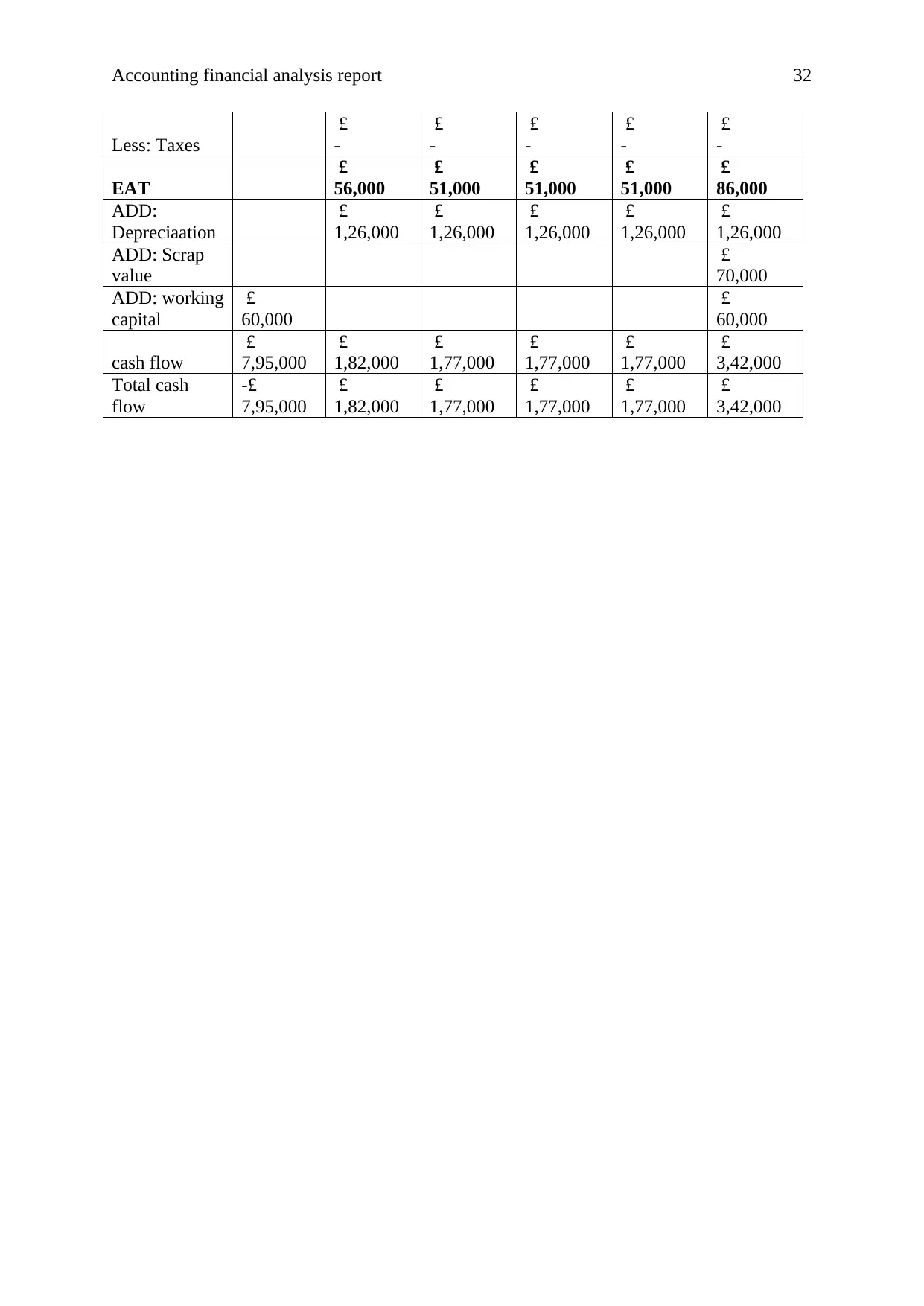
Accounting financial analysis report 32
Less: Taxes
£
-
£
-
£
-
£
-
£
-
EAT
£
56,000
£
51,000
£
51,000
£
51,000
£
86,000
ADD:
Depreciaation
£
1,26,000
£
1,26,000
£
1,26,000
£
1,26,000
£
1,26,000
ADD: Scrap
value
£
70,000
ADD: working
capital
£
60,000
£
60,000
cash flow
£
7,95,000
£
1,82,000
£
1,77,000
£
1,77,000
£
1,77,000
£
3,42,000
Total cash
flow
-£
7,95,000
£
1,82,000
£
1,77,000
£
1,77,000
£
1,77,000
£
3,42,000
Less: Taxes
£
-
£
-
£
-
£
-
£
-
EAT
£
56,000
£
51,000
£
51,000
£
51,000
£
86,000
ADD:
Depreciaation
£
1,26,000
£
1,26,000
£
1,26,000
£
1,26,000
£
1,26,000
ADD: Scrap
value
£
70,000
ADD: working
capital
£
60,000
£
60,000
cash flow
£
7,95,000
£
1,82,000
£
1,77,000
£
1,77,000
£
1,77,000
£
3,42,000
Total cash
flow
-£
7,95,000
£
1,82,000
£
1,77,000
£
1,77,000
£
1,77,000
£
3,42,000
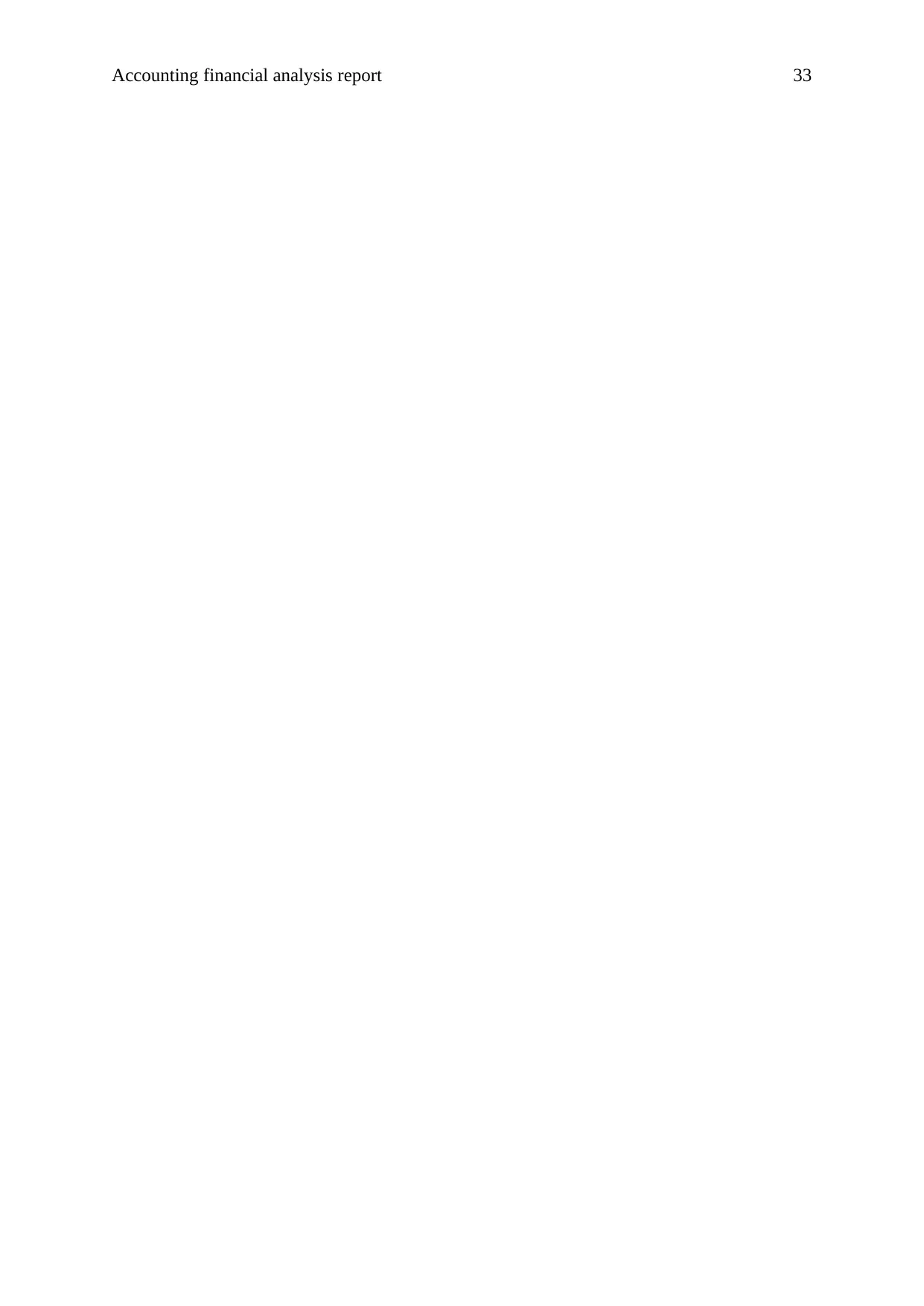
Accounting financial analysis report 33
1 out of 33
Related Documents
Your All-in-One AI-Powered Toolkit for Academic Success.
+13062052269
info@desklib.com
Available 24*7 on WhatsApp / Email
![[object Object]](/_next/static/media/star-bottom.7253800d.svg)
Unlock your academic potential
© 2024 | Zucol Services PVT LTD | All rights reserved.



![[FULL ACCESS] Financial Ratio Analysis](/_next/image/?url=https%3A%2F%2Fdesklib.com%2Fmedia%2Fimages%2Fyy%2Fb086e225468f48c29c15cc6583648a0c.jpg&w=256&q=75)

